According provided by YONGNUO LENS YN50mm F1.4 lens. Many thanks directly to Yongnuo.
Navigation
- In short
- History
- All lenses from Yongnuo
- Main Specifications
- Assembly
- Focusing
- Firmware Upgrade
- Image quality
- Examples of photos on the camera Kf = 1.0
- Examples of photos on the camera Kf = 1.6
- Sample photos in processing
- Differences from Canon 50 / 1.4 USM
- My experience
- Alternatives
- Price
- Results
- User Comments
- Add your review or question on the lens
In this review, the YONGNUO LENS YN50mm F1.4 will be abbreviated as 'Yongnuo 50 / 1.4'.
In short
Yongnuo 50 / 1.4 is a fifty-kopeck piece from Yongnuo for Canon cameras. Heavy, well-built, with decent image quality. It has a fairly low price tag and is a very attractive solution for amateur photographers. In fact, Yongnuo 50 / 1.4 is the cheapest autofocus lens with f / 1.4 for full-frame SLR cameras.
Yongnuo 50 / 1.4 turned out to be a worthy lens, it can be safely used for amateur photography. On full-frame cameras, this is a standard (in terms of focal lengths) lens with a very wide range of applications. On cropped cameras, the Yongnuo 50 / 1.4 can perform quite well as a replacement for a portrait lens.
Here I simply must leave a spoiler about fifty dollars. The creative and practical potential of a fast fifty dollars is really difficult to overestimate. It is suitable for a wide range of photo tasks. Photo enthusiasts often use it as a portrait lens, especially on cropped cameras (cameras with an APS-C or 4/3 sensor). Many just want a fast light fixed lens, in addition to its first kit lens. Diaphragm F / 1.4 exactly four steps wider aperture F / 5.6, which is used in the vast majority of 'dark' whale lenses at the long end. In numerical terms, this means that Yongnuo 50 / 1.4 is approximately 16 times brighterthan, for example, whale Canon EF-S 18-55 / 3.5-5.6 IS STMwhich uses a maximum relative aperture of only f / 50 at 5.6 mm of focal length. The calculation in the difference of the relative aperture (count the aperture) is performed elementarily: (5.6 * 5.6) / (1.4 * 1.4) = 16.
History
April 29 2014 at the show 'The 17th China International Photograph & Electrical Imaging Machinery and Technology' was presented prototype Yongnuo 50 / 1.4which outwardly was very similar to the original Canon 50 / 1.4 USM. After this exhibition prototype Yongnuo 50 / 1.4 did not appear anywhere else, mass production and its sales were not adjusted. Data from the official website has been deleted (but the internet remembers everything).
Below is a view of the prototype 'YONGNUO LENS EF 50mm 1: 1.4 YONGNUO LENS MADE IN CHINA':
30 May 2018 On the official website there is a modern Yongnuo 50 / 1.4 for Canon EOS cameras, shown in this review. Some people call this model Yongnuo 50 / 1.4 Mark II, I will not do that.
August 18 2018 was introduced Yongnuo 50 / 1.4NE for Nikon cameras.
All Yongnuo Lenses
Bayonet mount Sony FE [DF, FULL FRAME] и Sony E[DA,APS-C]:
- yongnuo 11 mm 1:1.8 DA DSM WL S [announcement]
- yongnuo 16 mm 1:1.8 DA DSM S [announcement]
- yongnuo 35 mm 1: 2 DF DSM S [review]
- yongnuo 50 mm 1: 1.8 DF DSM S [announce]
- yongnuo 50 mm 1:1.8 DA DSM S [overview]
- yongnuo 85 mm 1: 1.8 DF DSM S [review]
- yongnuo 85 mm 1:1.8 DF DSM S II [announcement]
Bayonet mount Canon RF (mirrorless full frame):
- yongnuo 35 mm 1: 2 DF DSM R [review]
- yongnuo 35 mm 1:2 CR [announcement]
- yongnuo 50 mm 1:1.8 DF DSM R [to be announced]
- yongnuo 85 mm 1:1.8 DF DSM R (two subversions with different names) [review]
Bayonet mount Nikon Z [DF, FULL FRAME + DA,APS-C]::
- yongnuo 11 mm 1:1.8 DA DSM WL Z [announcement]
- yongnuo 35 mm 1:2 DF DSM Z [announcement]
- yongnuo 50 mm 1:1.8 DF DSM Z [announcement]
- yongnuo 50 mm 1:1.8 DA DSM Z [review]
- yongnuo 85 mm 1:1.8 DF DSM Z [announcement]
Bayonet mount fujifilm x [DA,APS-C]:
- yongnuo 11 mm 1:1.8 DA DSM WL X [announcement]
- yongnuo 50 mm 1:1.8 DA DSM X Pro [Announcement]
- yongnuo 50 mm 1:1.8 DA DSM X [announcement + overview]
For the system Micro 4 / 3:
- yongnuo 25 mm 1: 1.7 [review]
- yongnuo 42.5 mm 1: 1.7 [review]
- yongnuo 42.5 mm 1:1.7 II [overview]
- yongnuo 12-35 mm 1:2.8-4 STM ASPH MACRO [announcement]
Bayonet mount Nikon f (mirrored full frame):
- yongnuo 14 mm 1: 2.8 [overview]
- yongnuo 35 mm 1: 2 [overview]
- yongnuo 40 mm 1: 2.8 [overview]
- yongnuo 50 mm 1: 1.8 [review]
- yongnuo 50 mm 1: 1.4 E [overview]
- yongnuo 60 mm 1:2 MACRO MF [overview]
- yongnuo 85 mm 1: 1.8 [overview]
- yongnuo 100 mm 1: 2 [overview]
Bayonet mount Canon EF (mirrored full frame):
- yongnuo 14 mm 1:2.8 [review N]
- yongnuo 35 mm 1: 2 [review]
- yongnuo 35 mm 1: 1.4 [overview]
- yongnuo 35 mm 1: 1.4C DF UWM [announce]
- yongnuo 50 mm 1: 1.8 [overview]
- yongnuo 50 mm 1:1.8 II [overview]
- yongnuo 50 mm 1: 1.4 [overview]
- yongnuo 60 mm 1:2 MACRO MF [review N]
- yongnuo 85 mm 1: 1.8 [review]
- yongnuo 100 mm 1: 2 [overview]
Cameras:
- Yongnuo YN433 (2023, Micro 4/3, 20 MP, 4K)
- Yongnuo YN455 (2021, Micro 4/3, 20 MP, 4K)
- Yongnuo YN450/450M (2019, Micro 4/3 -> Canon EF, 16 MP, 4K)
Lenses and cameras and many other products from Yongnuo can easily be found at Authorized Yongnuo Dealer / Store on Aliexpres.
My video on all Yongnuo lenses here.
Main technical characteristics of YONGNUO LENS YN50mm F1.4
| Review Instance Name | Near the front lens: YONGNUO LENS YN50mm F1.4 Ø58mm YONGNUO LENS MADE IN CHINA. On the YOUNGNUO DIGITAL 50mm. On the box: YOUNGNUO DIGITAL Standart prime lens YN50mm F1.4 |
| Basic properties |
|
| Front Filter Diameter | 58 mm, metal thread for filters |
| Focal length | 50 mm
|
| Zoom ratio | 1 X (this is a fixed lens, it does not have a zoom) |
| Designed by | for full-format digital cameras. The lens is suitable for everyone. Canon EOS cameras |
| Number of aperture blades | 7 rounded petals |
| Tags | bayonet mount tag, window with a scale for focusing distances in meters and feet, DOF scale (only for F / 22) |
| Diaphragm | F / 1.4 to F / 22 |
| MDF | 0.45 m, maximum magnification factor 0.15x (1: 6.67) |
| The weight | 572 g |
| Optical design | 9 elements in 7 groups. The lens uses special optical elements with an extremely high refractive index (shown in blue)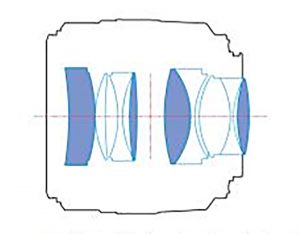 |
| Lens hood | Bayonet type hood. The hood is not included in the delivery, the instruction does not indicate its type / marking. Fit Canon ES-71II or any clone of it |
| Manufacturer country | MADE IN CHINA (Made in China) |
| Period | May 30, 2018 |
| Instructions | View my scan (English only) |
| Price | Aliexpress prices (cheapest) |
The optical design of the lens attracts a massive concave front element. Most likely the optical design takes its roots from Carl Zeiss 1,8 / 50 UltronVoigtlander Color-ultron 1.8 / 50. Of modern autofocus lenses, a similar concave front element can be found in Carl Zeiss Sonnar FE 1,8 / 55 ZA T * (Aka Sony SEL55F18Z FE 1,8 / 55) Most likely, the optical scheme of the Yongnuo 50 / 1.4 belongs to some old and unreleased Nikon / Canon lens, which did not reach mass production. thanks Dmitry Evtifeev for thoughts about the origin of the optical design of this lens.
Assembly
The lens came to the review completely new.
In a small box is a warranty card, instructions in Chinese and English, a card with a production date of 30-07-2018, a desiccant and the lens itself with a front (YN-58) and a back cover. The front and rear lenses of the lens are initially covered with special transport films of blue color. Unfortunately, one of these films left a small mark on the front lens, which I easily cleaned with a special cloth for optics.
In general, the lens is well assembled. Yongnuo 50 / 1.4 has metal mount mount. The focus ring is not rubberized, plastic, but wide enough and pleasant to use. The lens housings are made mainly from metal. The thread for the filters is also metal. It is stated that the contacts of the microprocessor are gold-plated.
The weight of the Yongnuo 50 / 1.4 is almost 600 grams. In the hands of the lens, it feels like a solid thing, many times better than Yongnuo 50 / 1.8 II. Yongnuo 50 / 1.4 lens weighs about the same as TOP original Canon 50 /1.2 L USM. Paired with fairly heavy cameras, the Yongnuo 50 / 1.4 allows you to get a good weight balance of the camera + lens bundle.
The design of Yongnuo 50 / 1.4 is very similar to Canon Compact-Macro 50 / 2.5.
Diaphragm consists of 7 petals and form a hole in the shape of a regular heptagon, while in the photographs in the blur zone rather round discs of blur appear in the range F / 1.4-F / 2.5.
The lens has a USB port in the lower rear of the lens (in the bayonet area). The port serves to update the firmware (described in detail about this in the relevant chapter) The USB port does not have a rubber plug.
Unfortunately, the bundle does not include a hood, a bag for transportation, a USB cable and a software disk (software can only be downloaded from the official website).
Canon ES-50 II hood is suitable for Yongnuo 1.4 / 71. I used analog Hoods Canon ES-71 II (for original lens Canon 50 / 1.4 USM). The hood mounts on the lens barrel rather than the retractable 'trunk', which adds strength to the structure and also makes front lens movement less noticeable. Important: this lens hood is not installed in the opposite direction (in transport mode), the lens is too thick and the lens hood is stuck in the middle.
Yongnuo 50 / 1.4 does not have a rubber mount mount and is not an all-weather lens.
UPDATE 1: Once I partially unscrewed the front lens block together with a polarizing filter, after which I screwed the block very tightly back and the similar embarrassment was no longer repeated.
UPDATE 2: I visited the review version YONGNUO LENS YN50mm F1.4N E for Nikon cameras, which was immediately out of the box with a loose, half-unscrewed trunk. I tightly twisted my arms around the trunk and a similar problem was no longer repeated.
Focusing
For focusing, Yongnuo 50 / 1.4 uses micro motor and is an analog of Canon MM (Micro Motor). Auto focus will work with any SLR camera Canon EOS. Most likely, mirrorless cameras with an appropriate adapter should not have any special problems.
Focus speed average (closer to low), significantly lower (about 2 times) than the original lens Canon 50 / 1.4 USM. Auto focus is very noisy.
When shooting a video using auto focus and the built-in microphone in the camera, the noise level is very strong. This noise from the focus motor makes viewing the captured video unpleasant.
I worked with the lens on the camera Canon EOS 5D с simple 9-point focusing system and on camera Canon EOS 750D (aka Canon Digital Rebel T6i, aka Canon Kiss Digital X8i) from 19-point advanced focusing system and Hybrid CMOS AF III for live view focus. Focusing tenacity is not bad, but still there are more focus errors than you might expect. Focusing errors are unsystematic and are often associated with low depth of field at F / 1.4.
On camera Canon EOS 750D I checked the presence of the back and focus front at different focusing distances (infinity and MDF as well). The shots taken using the Live View mode (which theoretically does not suffer from back / front focus) were used as a measure. Focusing accuracy using phase focus sensors, both central and lateral, completely coincided with the Live View mode. On camera Canon EOS 750D all focus modes in Live View work well, including focus with automatic face detection.
The focus ring is plastic, wide, in manual focus mode it rotates approximately 225 degrees (5/8 of a full 360 degree view). When extreme positions are reached, the ring does not abut, but continues to rotate very slowly and very tightly. Manual focus is convenient. During manual focusing is heard annoying sound like 'plastic rubs against plastic or metal', while the ring rotates smoothly and quite pleasantly. When changing the direction of focus, there is small lag (delay), but it does not cause much discomfort.
I used manual focus on the Yongnuo 50 / 1.4 for two days, shooting more than two thousand frames in this mode. Manual focus is really convenient, although there are unpleasant little things described above.
There is an 'AF-MF' (auto focus / manual focus) focus mode switch on the lens barrel. Switch positions are reversed compared to original lenses ('AF-MF' <-> 'MF-AF'). During auto focus focus ring remains stationarywhile it can be freely rotated 360 degrees without any effect on focusing. Unfortunately, unlike many original Canon lenses, the Yongnuo 50 / 1.4 does not support Canon FTM (or similar) manual focus control. The direction of rotation of the focus ring is opposite to the original Canon 50 / 1.4 USM.
Lens does not have internal focus, during focusing, the frame of the body ('trunk') moves forward about 1.5 centimeters, while front lens does not rotate. It is possible to use various filters without any problems.
The minimum focusing distance is 45 cm, while you can get the maximum magnification for macro photography 1: 6.67, which is typical for a large number of such fifty dollars.
Very important: During focusing to infinity, when the focusing ring is fully extended (with a slight overshoot beyond the 'infinity' mark itself), the mirror of full-frame cameras such as the Canon EOS 5D clings to the rear lens or the rear lens barrel. Usually, the mirror does not fall back, resting on the lens or rear lens frame of the Yongnuo 50 / 1.4. When the lens is focused to infinity without this slight overshoot, there are no problems with the mirror.
The lens has a window with a distance scale with marks in meters and feet. The scale is small, on it there are marks for 3, 1.5, 1, 0.8, 0.6, 0.5, 0.45 meters and a label of 'infinity'. There is also a label with the depth of field scale, but only for the value of F / 22. There is no tag for working in the infrared spectrum.
Other focusing features:
- on the distance scale, the focus ring has a large 'travel beyond infinity'. The Yongnuo 50 / 1.4 does not have a hard infinity mechanical stop that allows you to accurately and quickly focus the lens to infinity under any external temperature conditions. For accurate aiming at infinity, you cannot just bring the focusing ring to its extreme position.
- Focus shift (shift-focus) is missing.
- Yongnuo 50 / 1.4 has a tangible 'Focus Breathing' effect (changes in viewing angle during focusing). During focusing towards the MDF, the viewing angle decreases.
- Teleconverter compatibility unknown
- Focusing is performed by simultaneously moving the entire lens block (all lenses) relative to the focal plane
Important: Yongnuo 50 / 1.4 - a lens from a third-party manufacturer. It may happen that it will not work correctly with some Canon cameras. It is authentically known that the lens has focus problems including Live View on cameras Canon 6D, 6D Mark II, 5D, 5D Mark II, 5D Mark III, 60D.7D 750D.
USB firmware update
On the lens housing of the Yongnuo 50 / 1.4 there is a USB port with which you can update the lens software (firmware / firmware). Unfortunately, the functionality of the YNLensTool Updater Version 1.00 program, which is responsible for working with the lens, is very meager. You can only see the current firmware version and update it to a new one. Firmware versions can be found on the official website. I found firmware v1.03 for my Yongnuo 50 / 1.4 here.
A widespread USB 2.0 MICRO-B port (like mobile phones) is used for connecting to the lens. A USB cable is not included. To connect, I used a USB cable for my android phone. My lens had the latest firmware V1.03 (2018.6.27), and therefore I did not update it.
A firmware update, most likely, allows you to improve the compatibility of the lens with new cameras, improve the autofocus, eliminates some other errors. I appreciated the usefulness of this function when working with the lens Yongnuo 100mm 1: 2 for Nikon cameras. But still it’s very bad that there is no way to roll back (restore) the original firmware that came out of the box.
To upgrade the firmware (software) of the lens:
- Turn off the camera, detach the lens
- Open program YNLens Updater for updating (program for Window or MacOs can be downloaded on the official website here)
- Attach the lens to the computer using a USB cable. If everything went well, the program will automatically detect the connected lens
- Click [Browse] and select the file with the desired firmware
- Click [Start] to start the update. Wait for the update to finish
- Disconnect the cable, attach the lens to the camera and start shooting
UPDATE: some users have noted a deterioration in the quality of autofocus with the new firmware. I found the archive with the old firmware, you can download from this link.
Image quality
As for its class, Yongnuo 50 / 1.4 shows quite acceptable quality of the created image.
Sharpness
- in the center of the frame at F / 1.4 for resolution, nothing surprising, but still it is enough for many photo tasks
- F / 1.4 aperture at 24 megapixels of the cropped sensor shows itself weakly, at 12 megapixels full frame - good
- there is a noticeable drop in sharpness to the edges of the frame at f / 1.4
- good resolution in the center of the frame on covered apertures after F / 2
- good resolution at the edges of the frame on covered apertures after f / 4
- good contrast
Distortion
- small barrel distortion
- the overall level of distortion is at a level typical for such lenses
- the nature of distortion is unified, easily corrected in the editor
Vignetting
- general level vignetting is at the level typical for such lenses
- noticeable vignetting observed most strongly at F / 1.4-F / 2
- vignetting amplified with focus towards MDF
- on APS-C cameras with a sensor vignetting practically disappears at F / 2.0-F / 2.8
- vignetting easily fixable in the editor
- vignetting not amplified when using a sufficiently thick filter (with high sides)
Aberration
- open diaphragms have a noticeable amount of spherical and chromatic aberrations
- the strongest chromatic aberration visible at the edges and corners of the image
- general level HA is at the level typical for such lenses
- there is strong friging (HA in the blur zone) and blooming (HA on very contrasting small details)
- there is a strong coma in the corners of the image on f / 1.4-f / 2.0
Rest
- diaphragm forms fairly smooth discs of blur only in the range of F / 1.4-F / 2.5, at values of F / 2.8-F / 22 you can clearly trace the regular polygons from point light sources in the blur zone.
- color rendering is neutral, pleasant. The lens uses front lens enlightenment, which casts green shades. Many modern lenses have enlightenment that shimmers like the Yongnuo 50/1.4.
- in some situations, the lens is very afraid of side and back light. The lens can catch a noticeable flare of the frame.
- the wide aperture of F / 1.4 creates a strong blur of the front / rear plan, while the nature of the bokeh is quite even and pleasant. It should be noted that bokeh perception is mostly a subjective factor.
On covered apertures starting at about F / 2.8, distinguish between Yongnuo 50 / 1.4 and Canon 50 / 1.4 USM it will be extremely difficult.
Important: at the time of writing this review, there was no Yongnuo 50 / 1.4 profile for popular RAW converters. But I noticed that for Yongnuo 50 / 1.8 lenses for Nikon / Canon, as well as for Yongnuo 35 / 2.0 for Canon, lens profiles for Adobe Camera Raw and Adobe Lightroom of the latest versions have already appeared, therefore, most likely, the appearance of a lens profile for Yongnuo 50 /1.4 is just a matter of time.
Full frame sample photos
All sample photos in the gallery below were shot using a camera Canon EOS 5D and the Yongnuo 50 / 1.4 lens. Photos taken using RAW ('.CR2') file conversion with Canon original utility Digital Photo Pprofessional 4 (Canon DPP) without any changes (without treatment).
RAW source photos ('.CR2') can be downloaded at this link... Original 'JPEG' photos can be download from this link.
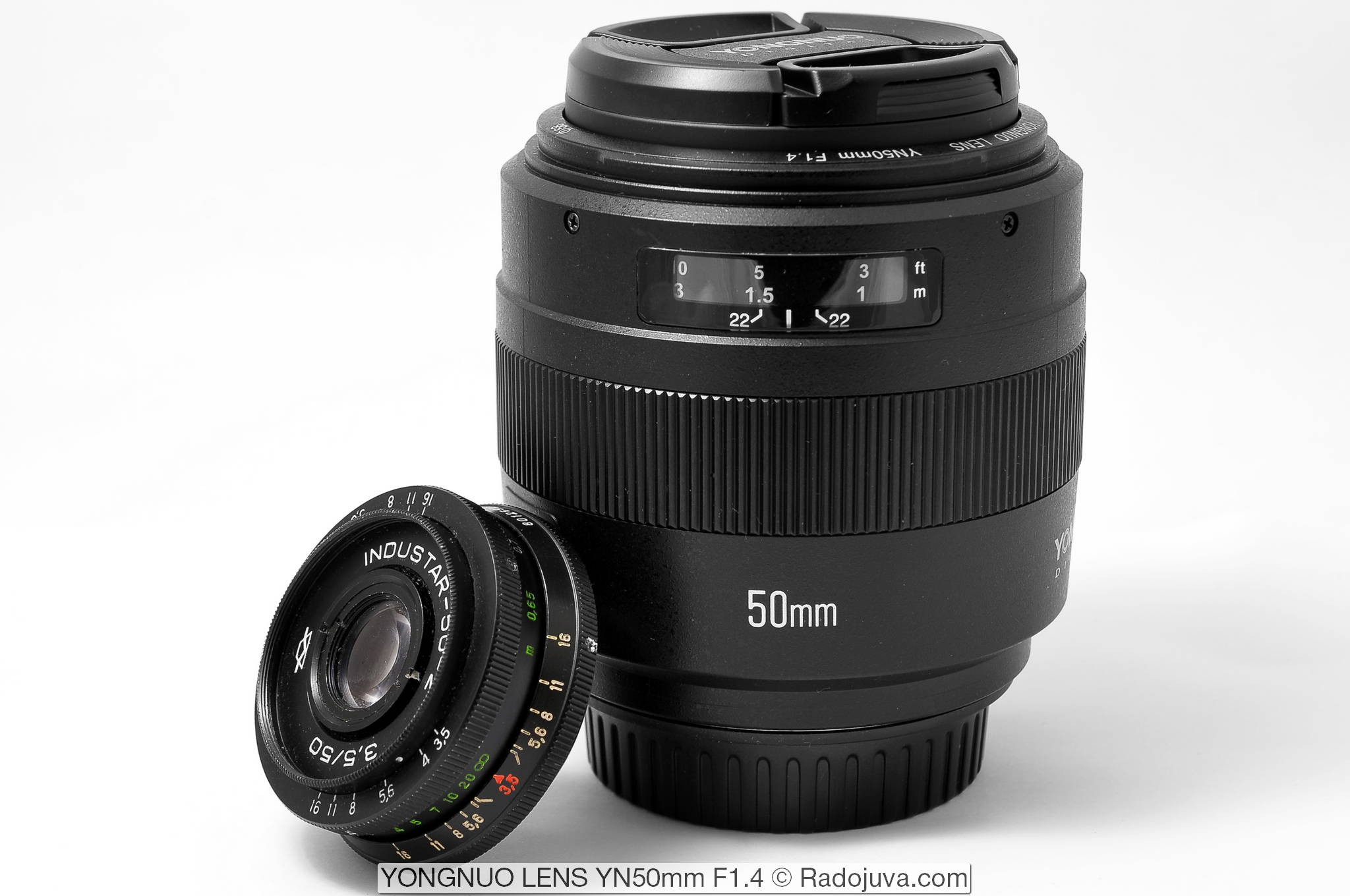
Manual baby fifty dollars INDUSTAR-50-2 3,5 / 50 and modern Yongnuo YN 50mm f / 1.4
Sample photos on crop
All sample photos in the gallery below were shot using a camera Canon EOS 750D (aka Canon Digital Rebel T6i, aka Canon Kiss Digital X8i) and a Yongnuo 50 / 1.4 lens without a hood. On-camera JPEG without additional processing. Let me remind you that the pixel density of 750D 20% higher than fifty megapixel Canon EOS 5Dsr/Canon EOS 5DS. Some photos were taken using a polarizing filter. HOYA 58mm PL-CIR.
Photos in the gallery are reduced in size, resize up to 2048 X 1535 pixels (about 3.1 MP) was taken using the free software FastStone Photo Resizer 3.1. Data was imprinted at the bottom of the photos. EXIF (excerpt, aperture, ISO). When reducing the size of photos, I use a quality equal to 80% of the original. This percentage of quality is more than enough to convey all the details in the photo without the excess weight of the file in the 'JPEG'. With 3 MP, you can print photos up to A4 without any problems. The light weight of the photos allows you to quickly view sample photos for general acquaintance with the capabilities of the lens and allows you to save photo loading time and disk space on my site. When viewing photos on the display of different devices, the site automatically adjusts the photos to the size of the device used. To view a 1: 1 photo pixel by pixel, just open it in a new browser tab, do it as easy as clicking on the photo thumbnail with the middle mouse button (by scrolling) or using the 'open link in a new tab / window' context menu.
'JPEG' source photos can be download from this link... Original RAW ('.CR2') photos can be download from that link.
UPDATED
More sample photos for this lens can be found in the Canon EOS 5D review.
Sample photos in processing
Photos in small processing can look in my gallery on the service 500Px.
Differences from Canon 50 / 1.4 USM
At the time of this review, Canon only had one such lens, namely Canon 50 / 1.4 USM, with him I will compare Yongnuo 50 / 1.4.
Advantages of Canon 50 / 1.4 USM over Yongnuo 50 / 1.4:
- Canon 50 / 1.4 USM uses 8 aperture blades. Yongnuo 50 / 1.4 aperture blades have only 7
- Canon 50 / 1.4 USM significantly smaller in size
- Canon 50 / 1.4 USM approximately twice as easy
- Canon 50 / 1.4 USM focuses much quieter
- Canon 50 / 1.4 USM focuses significantly faster
- Canon 50 / 1.4 USM uses Micro USM Ultrasonic Focusing Motorand Yongnuo 50 / 1.4 uses a conventional micro-motor
- Canon 50 / 1.4 USM has a feature continuous manual focus control Canon FTM
- Canon 50 / 1.4 USM additionally has infrared label
- Canon 50 / 1.4 USM has rubberized focus ring no lag
- Canon 50 / 1.4 USM has more usual directions rotate the focus rings and focus mode switch AF / MF
- Canon 50 / 1.4 USM Profile sewn into modern camerasthat can automatically correct some types of distortion, such as distortion or vignetting. Also, the profile for the Canon 50 / 1.4 USM is present in almost all modern RAW converters and allows you to quickly get rid of some distortions.
Advantages of Yongnuo 50 / 1.4 over Canon 50 / 1.4 USM:
- Yongnuo 50 / 1.4 25 years newer. Original Canon 50 / 1.4, which was introduced back in 1993
- Yongnuo 50 / 1.4 costs approximately half as much
- Yongnuo 50 / 1.4 uses more complex and unusual optical design... Canon 50 / 1.4 USM uses the classic Gaussian dual lens design, inherited from Canon FD 50mm f / 1.4 and used in a huge number of old 50 / 1.4 class XNUMXs (as an example - Nikon 50 / 1.4D)
- Yongnuo 50 / 1.4 has USB port for firmware upgrade
- Yongnuo 50 / 1.4 has more long stroke focus ringwider focus ring
The optical performance of both lenses is at a similar level. The network has user reviews where you can find information that the Yongnuo 50 / 1.4 is slightly better at open apertures in the center of the frame and slightly worse at the edges and corners than the original Canon 50 / 1.4 USM.
Alternatives
Below is a list of fifty-fifty lenses and lenses that are very close in their focal length to 50 mm, which support auto focus and are suitable for full-frame cameras Canon EOS.
Canon:
| Canon Lens EF 50mm 1:1.8, version with a focusing distance window and metal mount | March 1987 | View price |
|
Canon Lens EF 50mm 1:1.8 II, the second version without a window of focusing distances and a plastic bayonet mount. This lens exists in two subversions: Subversion fundamentally no different |
December 1990 | View price |
| Canon EF Lens 50mm 1:1.8 STM | May 2015 | View price |
| Canon EF Lens 50mm 1:1.4 Ultrasonic | July 1993 | View price |
| Canon EF Lens 50mm 1:1.2 USM Ultrasonic | January 2007 | View price |
| Canon EF Lens 50mm 1:1.0 l Ultrasonic | September 1989 | View price |
| Canon Compact macro Lens EF 50mm 1:2.5 | December 1987 | View price |
| Canon lens RF 50 mm F1.2 L USM | September 2018 | View price |
Tamron:
| Tamron SP 45mm F /1.8 Di VC USD F013 | September 2015 | View price |
Sigma:
| Sigma 50mm 1:1.4 DG HSM EX, this lens exists in two versions with a different type of body coating | March 2008 | View price |
| Sigma 50mm 1:1.4 DG HSM A (Art) | January 2014 | View price |
| Sigma 50mm 1:2.8 Macro | 1990 | View price |
|
Sigma 50mm 1:2.8 Macro EX, there was a copy of this lens under the name Quantaray 50mm 1:2.8 Macro |
1998 | View price |
| Sigma 50mm 1:2.8 DG Macro EX | June 2004 | View price |
Tokina:
| Tokina Opera 50mm F1.4 FF | February 2018 | View price |
Yongnuo:
|
There are several sub-versions with different spelling of the name near the front lens
Subversion fundamentally no different |
December 2014 | View price |
|
There are two options, depending on the color of the case: the black or white |
May 2018 | View price |
| Yongnuo Lens 50mm 1:1.4there was another prototype Yongnuo Lens EF 50mm 1:1.4 | May 2018 | View price |
My experience
Я ecstatic from Yongnuo 50 / 1.4. For a little money, it turned out to be a perfectly suitable fifty dollars with a fully functional F / 1.4 aperture (for some photo tasks).
I will dwell on the price separately. Yongnuo 50 / 1.4 is:
- cheapest autofocus fifty dollars for Canon SLR cameras with F / 1.4
- the cheapest fifty dollars among all autofocus fifty dollars with F / 1.4, which you can buy new
- the cheapest autofocus full-frame lens with f / 1.4
- Yongnuo 50 / 1.4 is cheaper than not only any full-frame lens with F / 1.4, but also any cropped lens with F / 1.4
Yongnuo 50 / 1.4 costs a little more than the original Canon 50 / 1.8 STM... F / 1.4 aperture is about 2/3 brighter than f / 1.8. As a result, what to choose is a difficult and open question. For myself, in particular for photography (not for video), I would still stick to Yongnuo 50 / 1.4. But for the video, I would still choose the original Canon 50 / 1.8 STM.
Not so long ago I had a brand new star super monster on the review HD PENTAX 1: 1.4 50mm SDM AW DFA * and I should note that Yongnuo 50 / 1.4 has much less pronounced longitudinal aberrations (fringing), which color contrast transitions in the blur zone in green and purple. Although, of course, in general HD PENTAX 1: 1.4 50mm SDM AW DFA * significantly better than the budget Yongnuo 50 / 1.4.
I took Yongnuo 50 / 1.4 several times for shooting as a lens for the second camera. Behind three weeks of viewing time I took about 6000 frames and did not notice any glitches or malfunctions in the Yongnuo 50 / 1.4.
Comments on this post do not require registration. Anyone can leave a comment. Many different photographic equipment can be found on AliExpress.
Prices
Yongnuo 50 / 1.4 is not a very expensive lens. Easiest and cheapest Buy Yongnuo 50 / 1.4 on aliexpress.comfor example verified seller here at this link.
Results
The Yongnuo 50 / 1.4 is a very functional lens for little money. Yongnuo has recently been producing increasingly sophisticated lenses with good capabilities. In many situations, Yongnuo 50 / 1.4 can be an excellent replacement for the original Canon 50 / 1.4 USM.
Advantages
- low cost ($ 150-180 for the new Yongnuo 50 / 1.4). It is the cheapest F / 1.4 AF lens of any AF lens.
- high aperture
- unusual / unique optical design. The optical scheme uses special elements with an extremely high refractive index. The front element is concave (a rarity for this kind of lens)
- USB port for firmware upgrade
- convenient manual focus, the focus ring rotates 225 degrees
- there is a window with a scale of focusing distances
- the filter frame does not rotate during focusing
- fixed focus ring during auto focus (e.g. Canon 50 / 1.8 II the ring rotates and cannot be touched)
- good build quality: metal bayonet mount, most of the body is metal, reliable and comfortable covers, bayonet type hood, hood is not mounted on the trunk
- depth of field scale, no focus shift
- seven-petal diaphragm, round discs of blur in the range of F / 1.4-F / 2.5
- nice / neutral drawing, which can be used as a good artistic technique during portraiture
- Confident sharpness starting at f / 1.4 in the center of the frame. Moderate level of basic optical distortion (aberration, vignetting, distortion) comparable to the original Canon 50 / 1.4 USM
Disadvantages
- limited options for adjusting the lens via the USB port. You can only upgrade the lens firmware. Cannot roll back firmware to previous version
- rear lens or rear lens barrel may interfere with the mirror of some full-frame Canon EOS cameras during 'infinity flight' focusing
- I once unscrewed a light filter along with the front of the lens (the problem was easily solved by more tightly screwing the front lens unit)
- high weight (572 grams in Yongnuo 50 / 1.4 versus 290 grams in Canon 50 / 1.4 USM)
- during focusing towards MDF, the front of the frame (trunk) moves forward
- average focusing speed, significantly lower than that of Canon 50 / 1.4 USM
- the usual micro focus motor and, as a result, the lack of the function of constant manual focus control similar to, for example, the FTM mode Canon 50 / 1.4 USM
- tangible noise from the focus motor
- unsystematic focusing errors (but it cannot be said that there are tangible problems with focusing)
- plastic focus ring, unpleasant rubbing sound during focusing
- a small lag of the focus ring during manual focus when changing the direction of rotation
- the direction of rotation of the focus ring is opposite to the original Canon 50 / 1.4 USM.
- no hoods included, no official information on compatible hoods
- there is no basic dust and moisture protection (for example, Nikon 50 / 1.4G there is a rubber mount seal)
- tangible effect of 'Focus Breathing' (changes in viewing angle during focusing)
- hole aperture at values F / 2.5-F / 22 it is poorly rounded and is a regular heptagon
- there is no tag for working in the infrared spectrum, the depth of field and focusing distances are small
- there is incompatibility with some cameras and / or teleconverters (no exact data)
- lack of data about the lens in modern cameras, which makes it difficult to automatically correct some types of optical distortion (distortion, vignetting etc.)
- lack of a lens profile in popular RAW converters (temporary drawback, you can create a profile yourself or wait for its release)
- the survivability of this lens and the variation in quality are unknown. Little information on Yongnuo Certified Lens Service Centers
- certain imperfections in the image (poor sharpness at F / 1.4 at the corners and edges of the image, poor resistance to side light without a lens hood, a set of optical distortions characteristic of such fifty dollars)
Material prepared Arkady Shapoval. Training/Consultations | Youtube | Facebook | Instagram | Twitter | Telegram

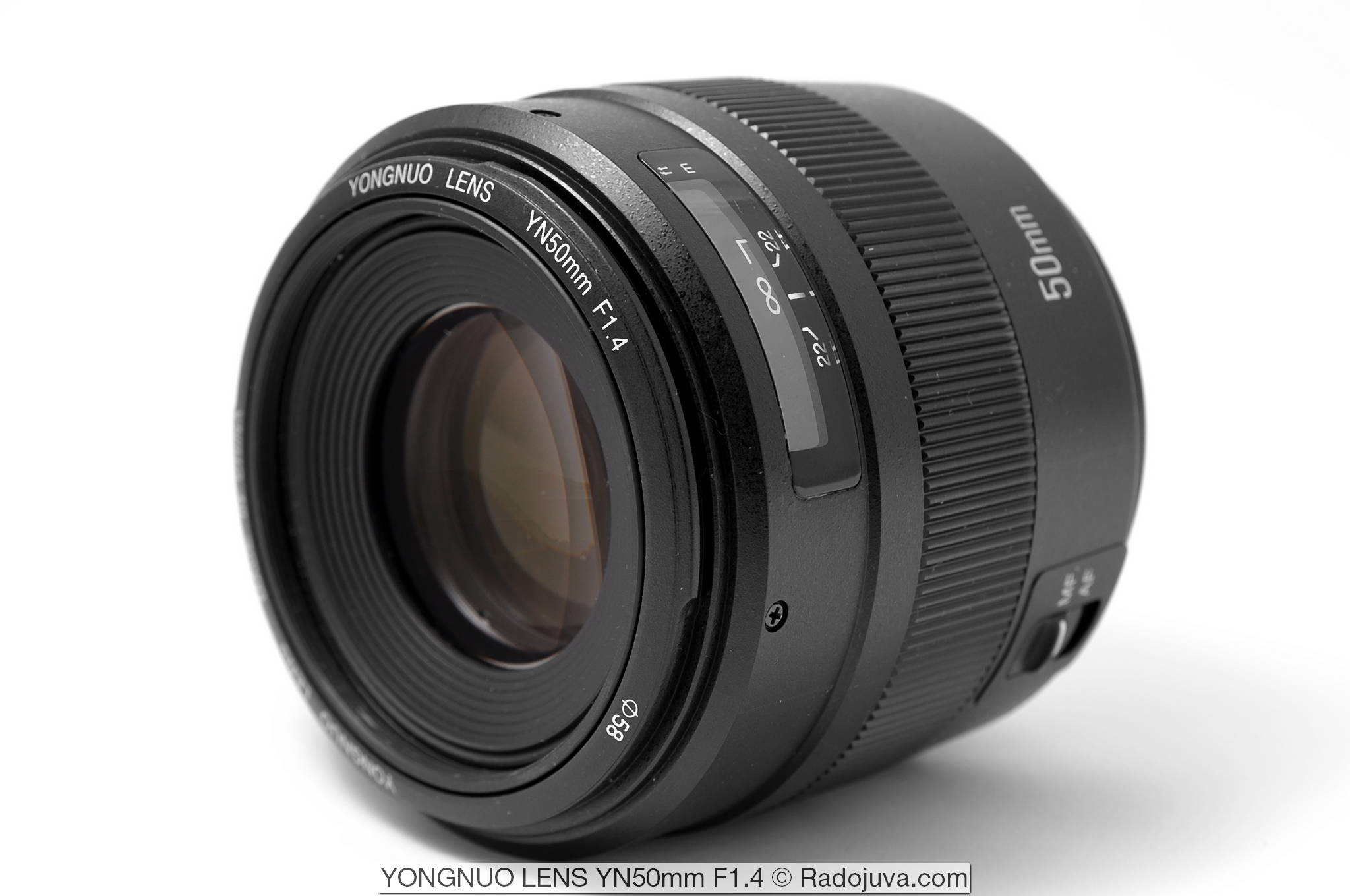
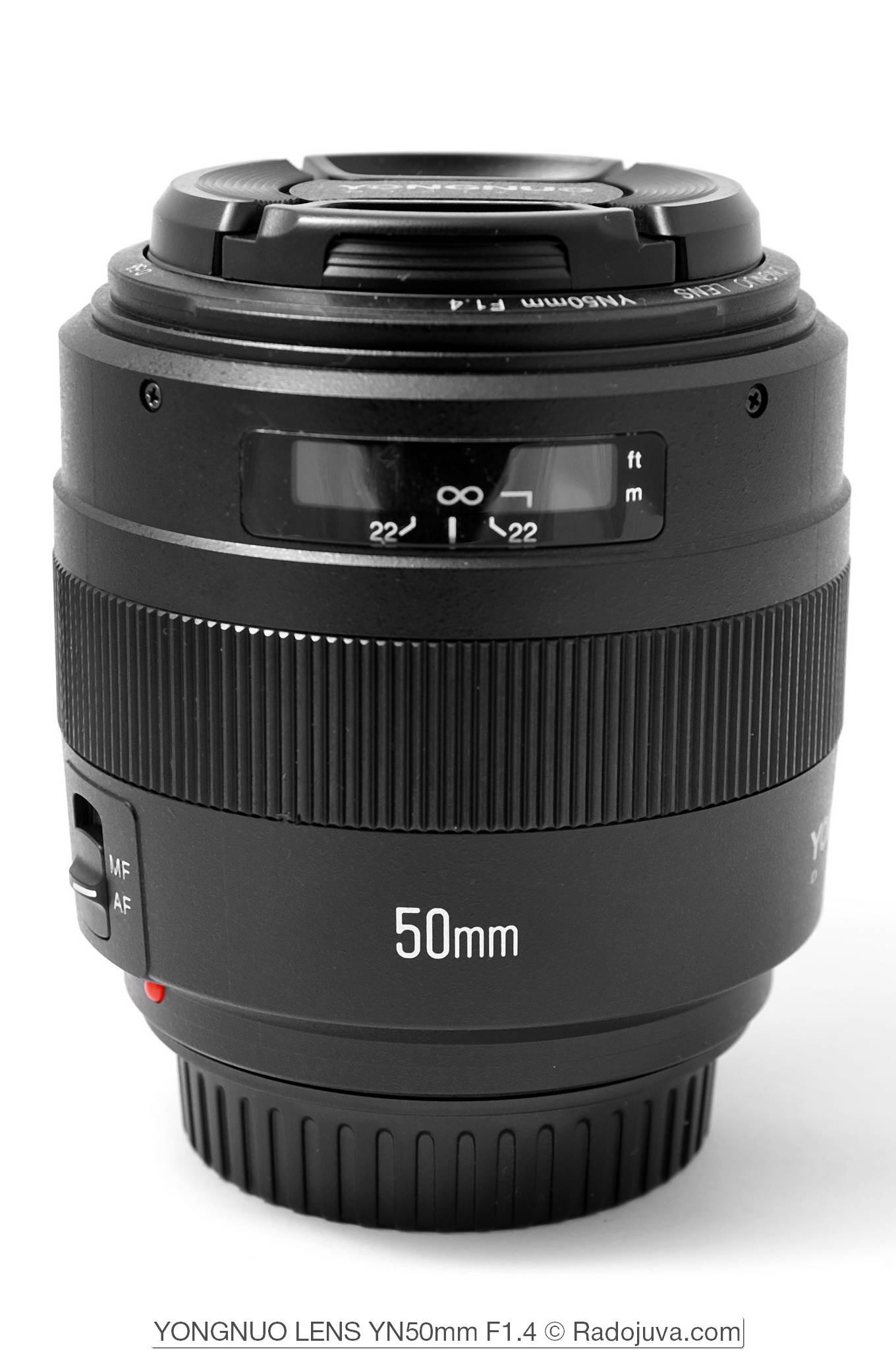
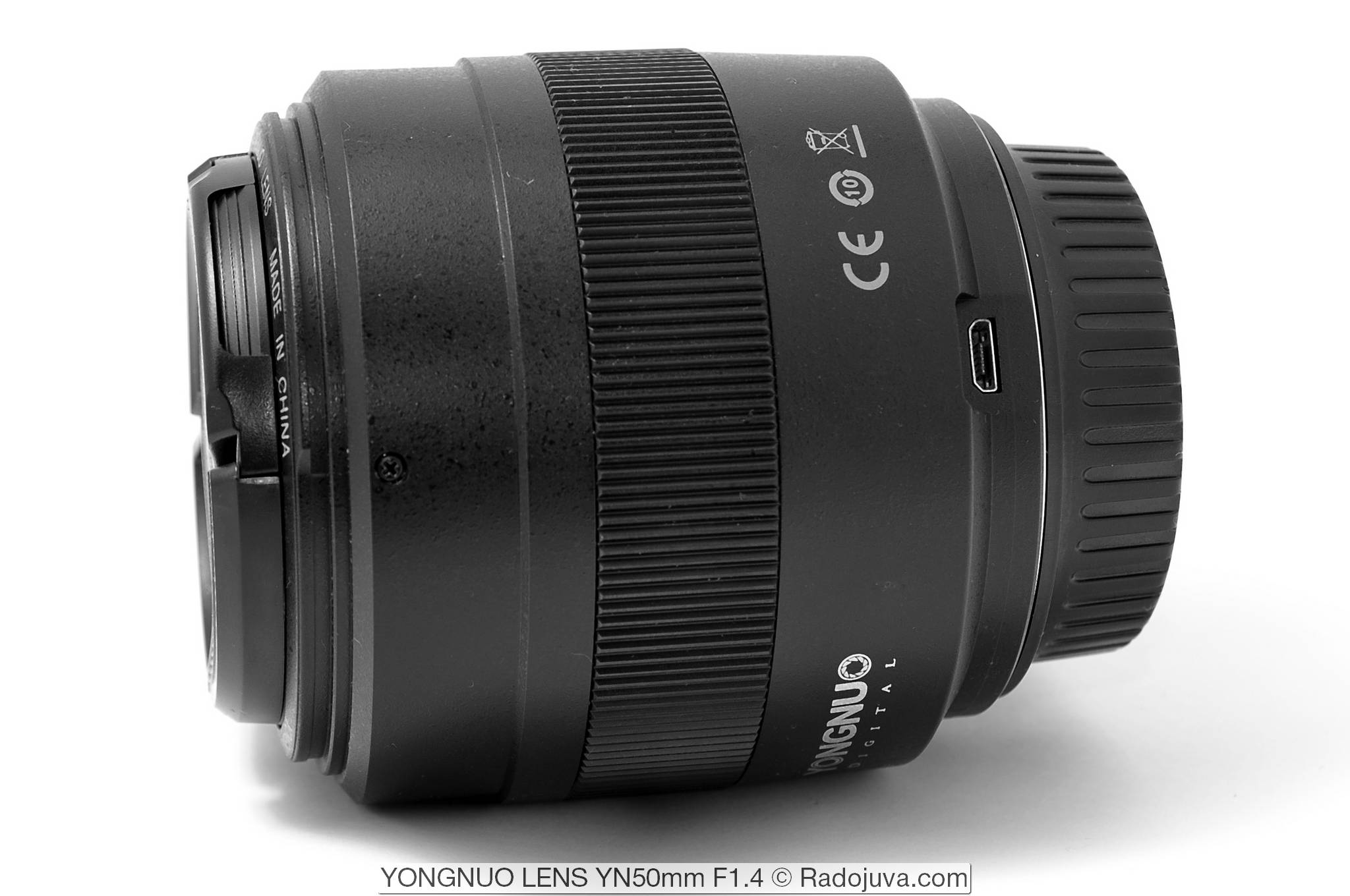





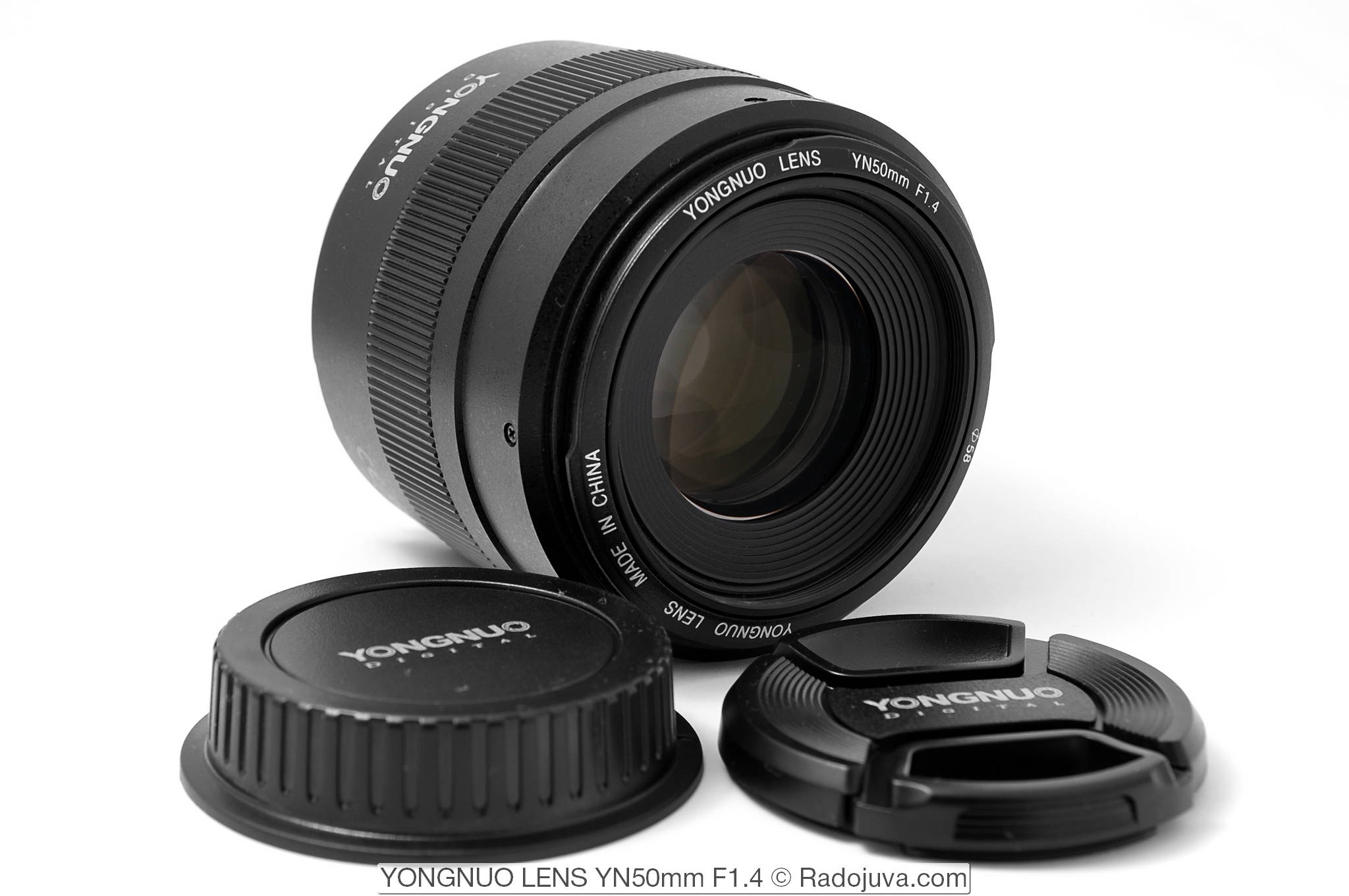
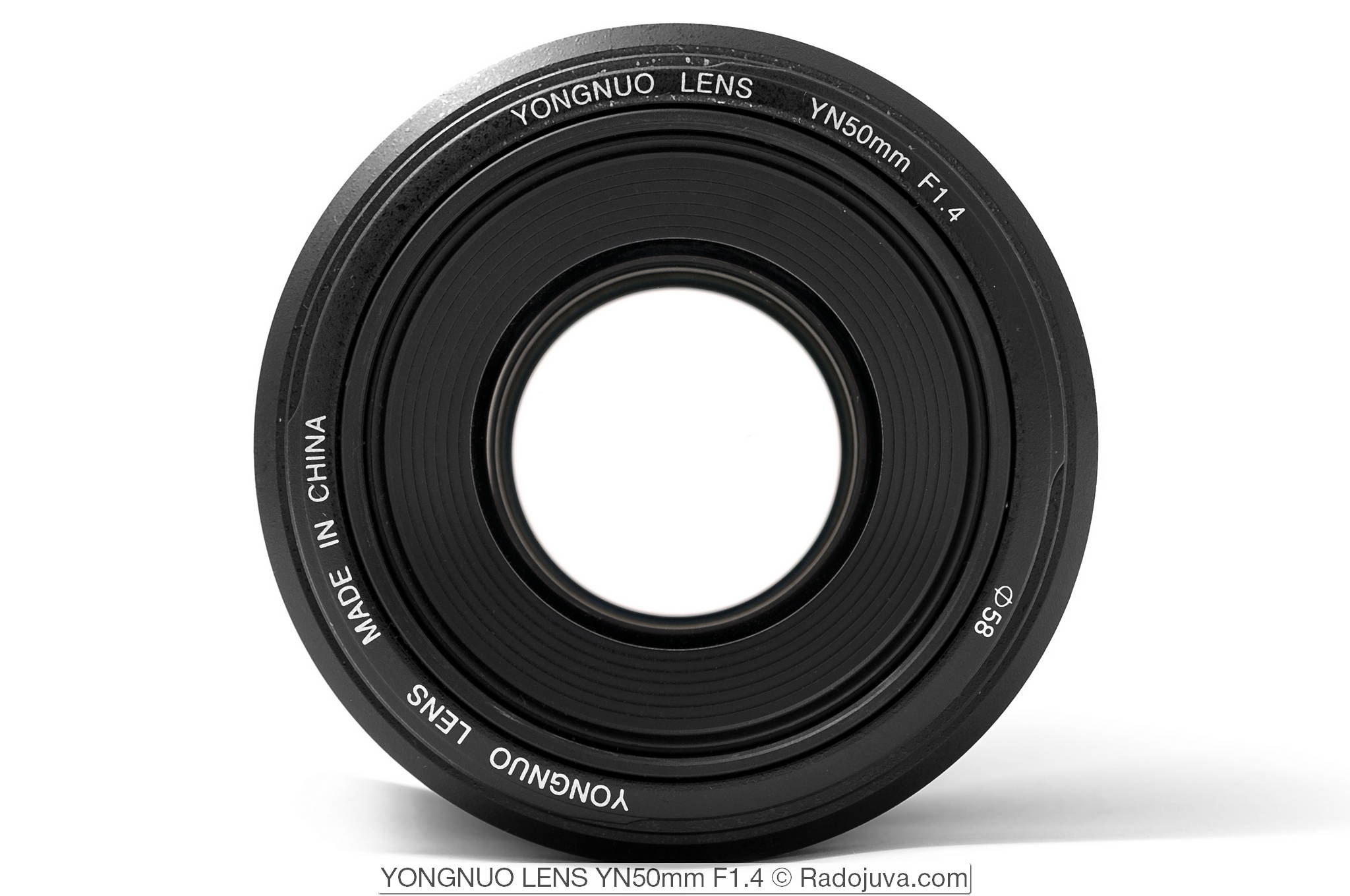
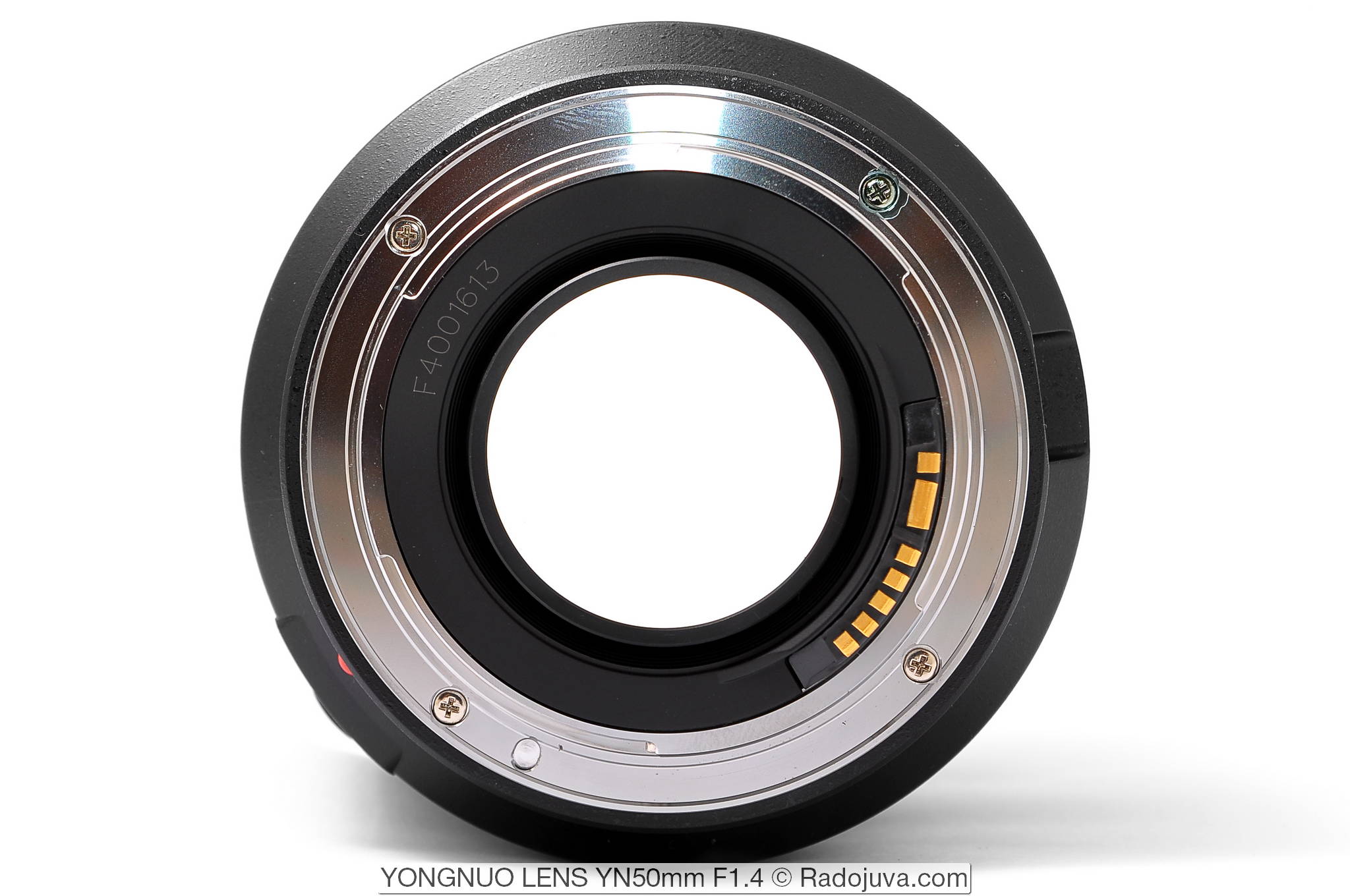
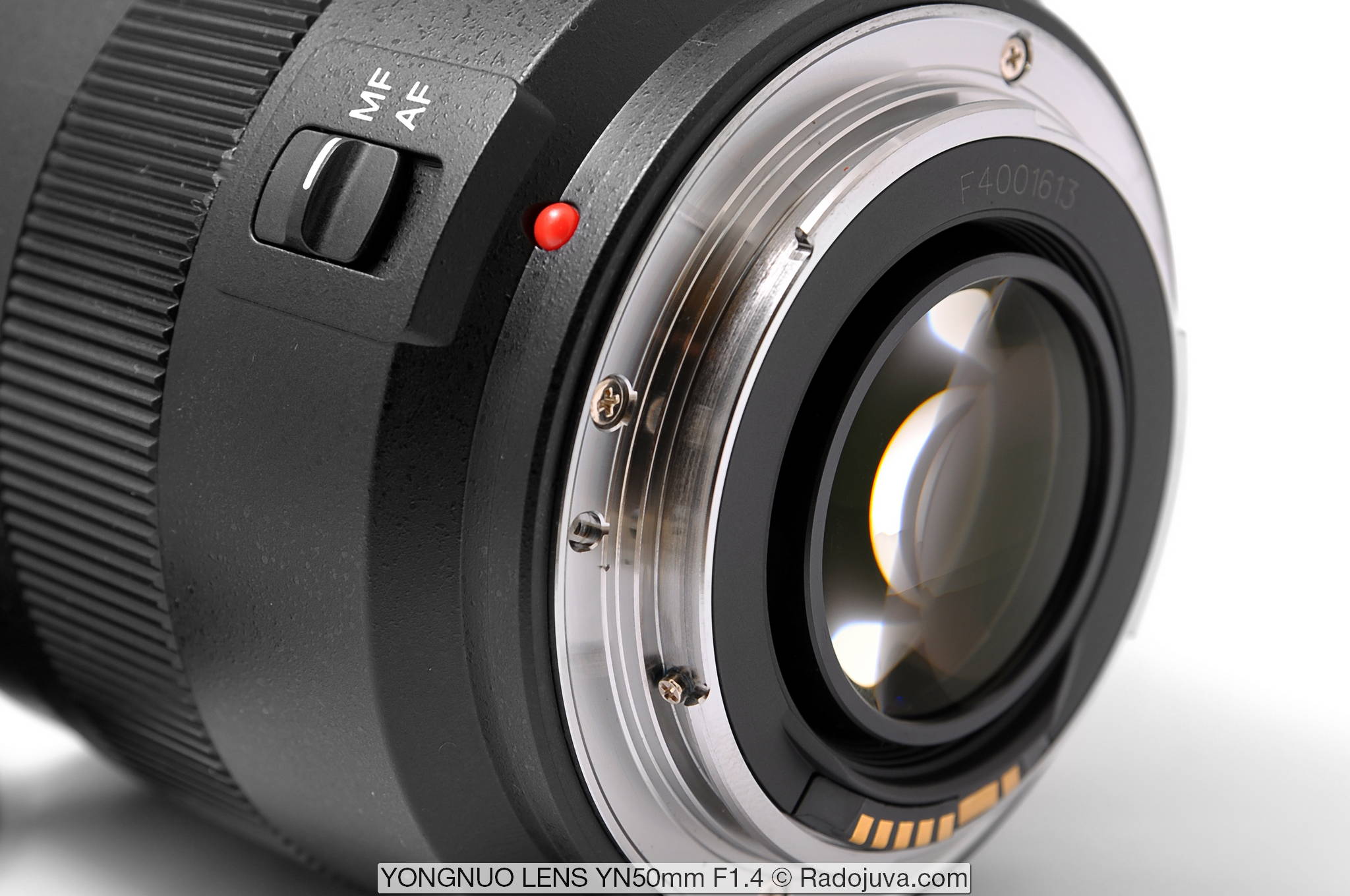
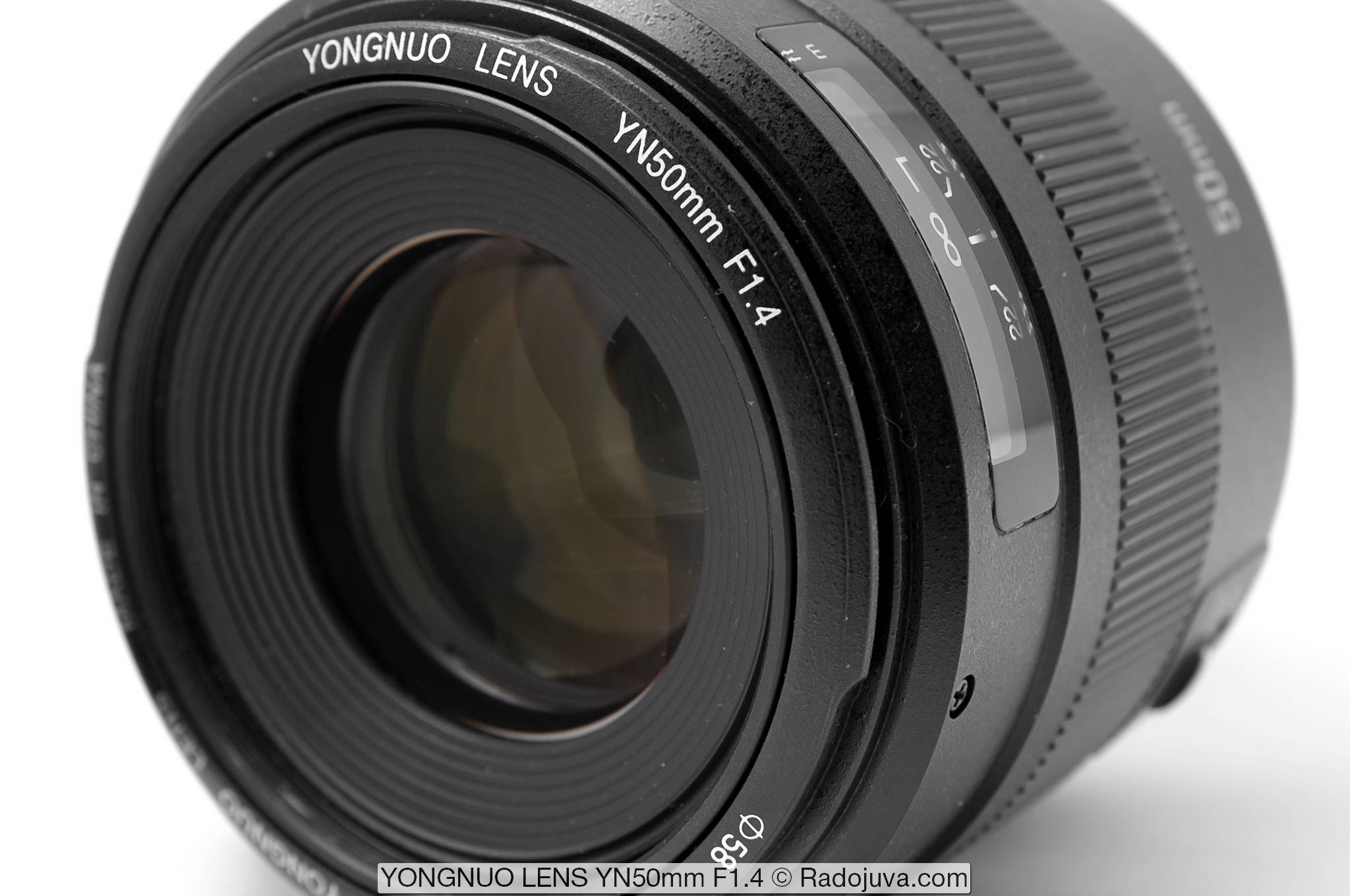
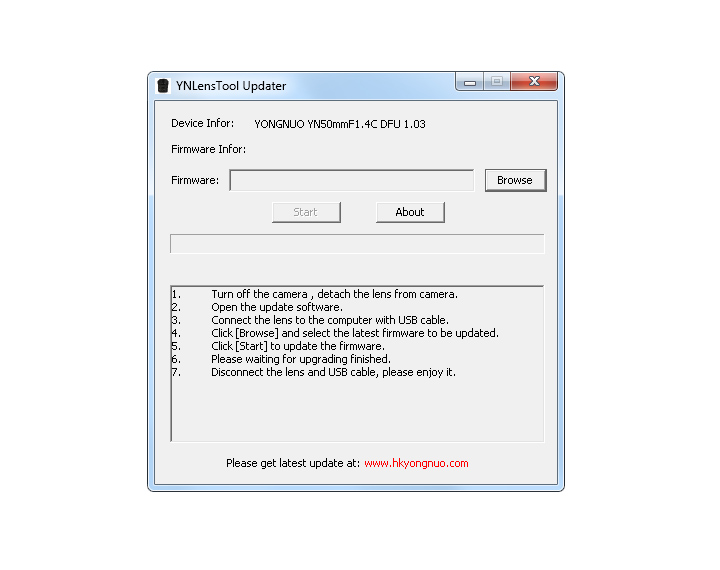
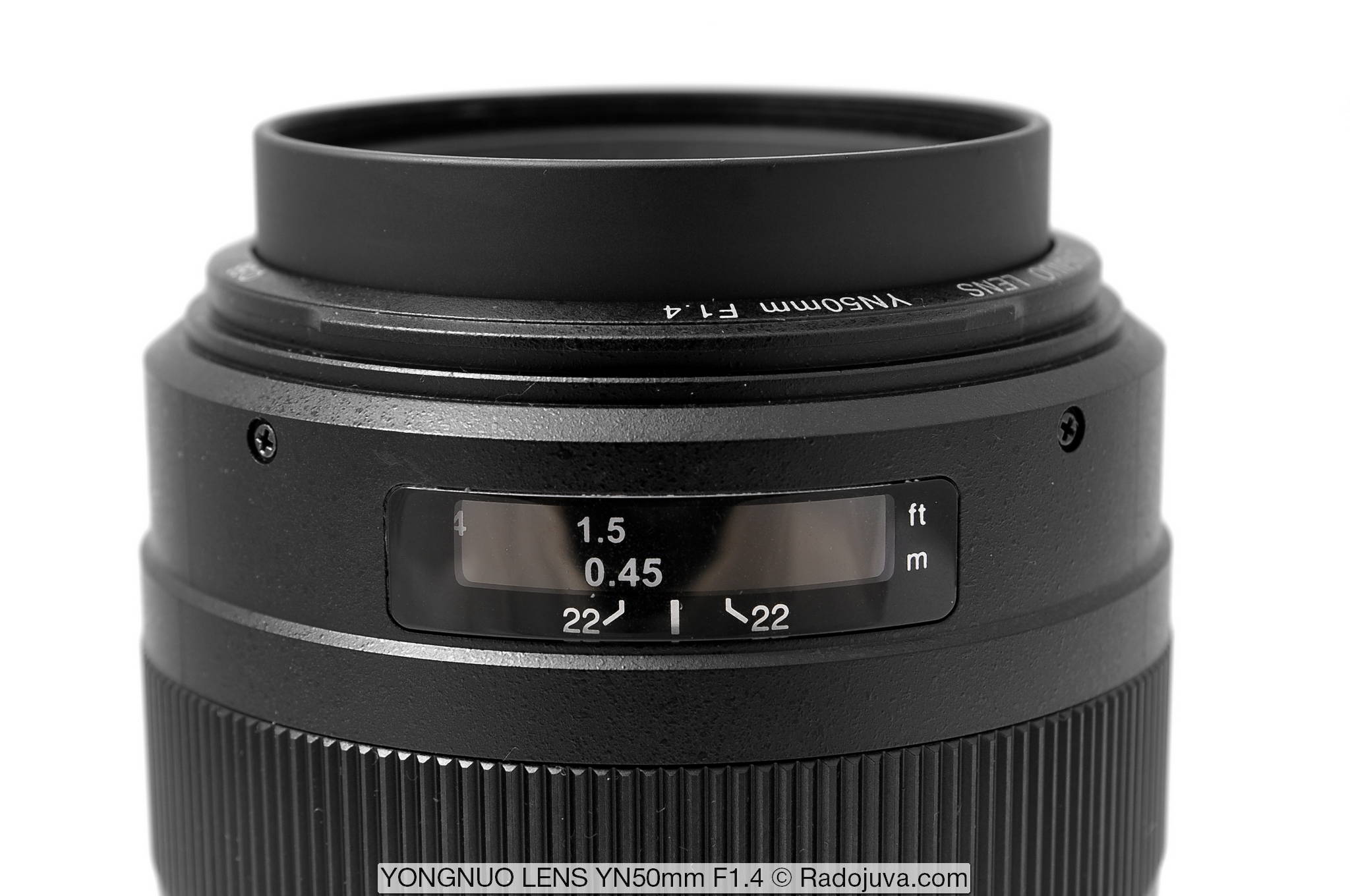
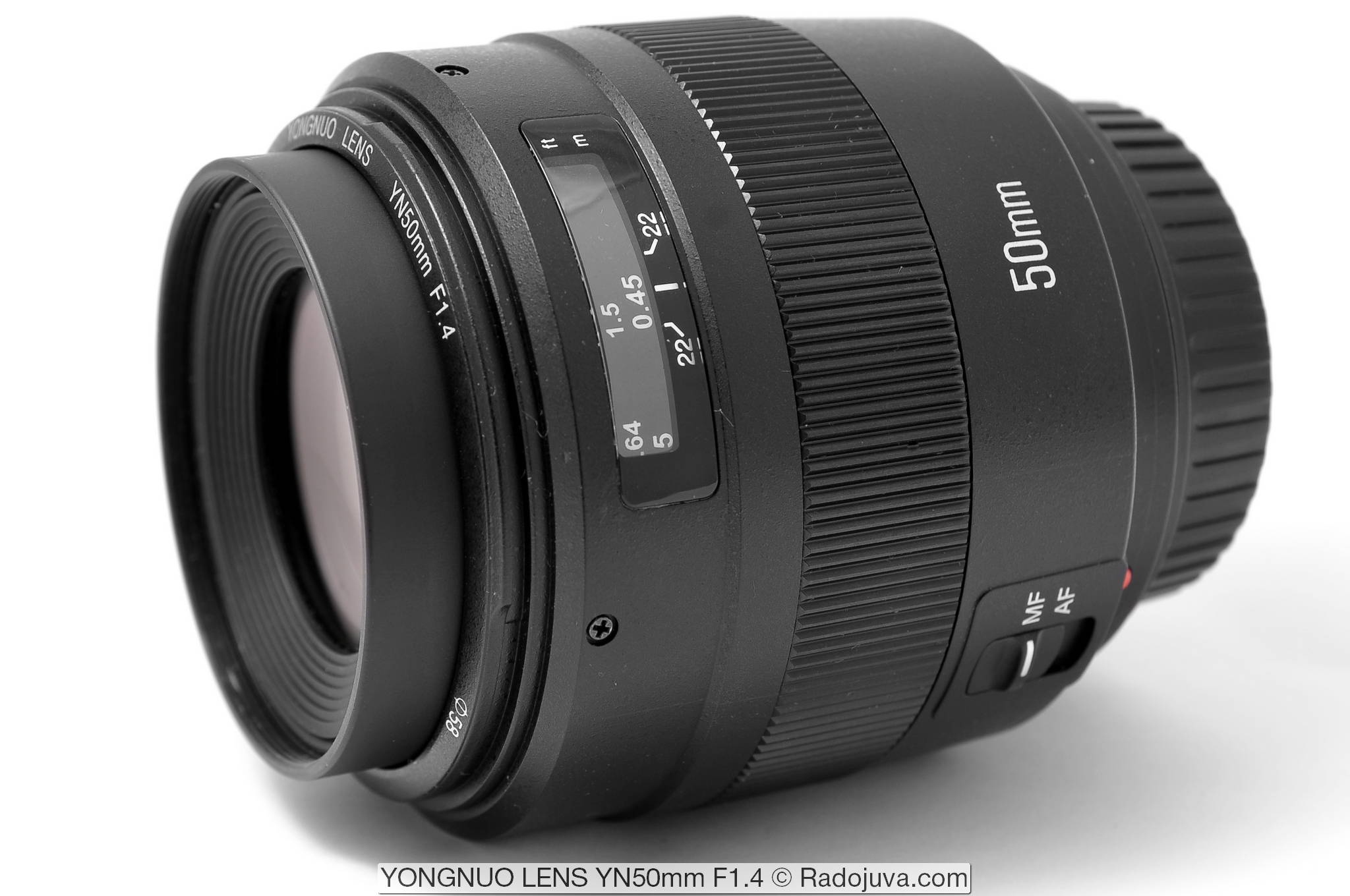































































































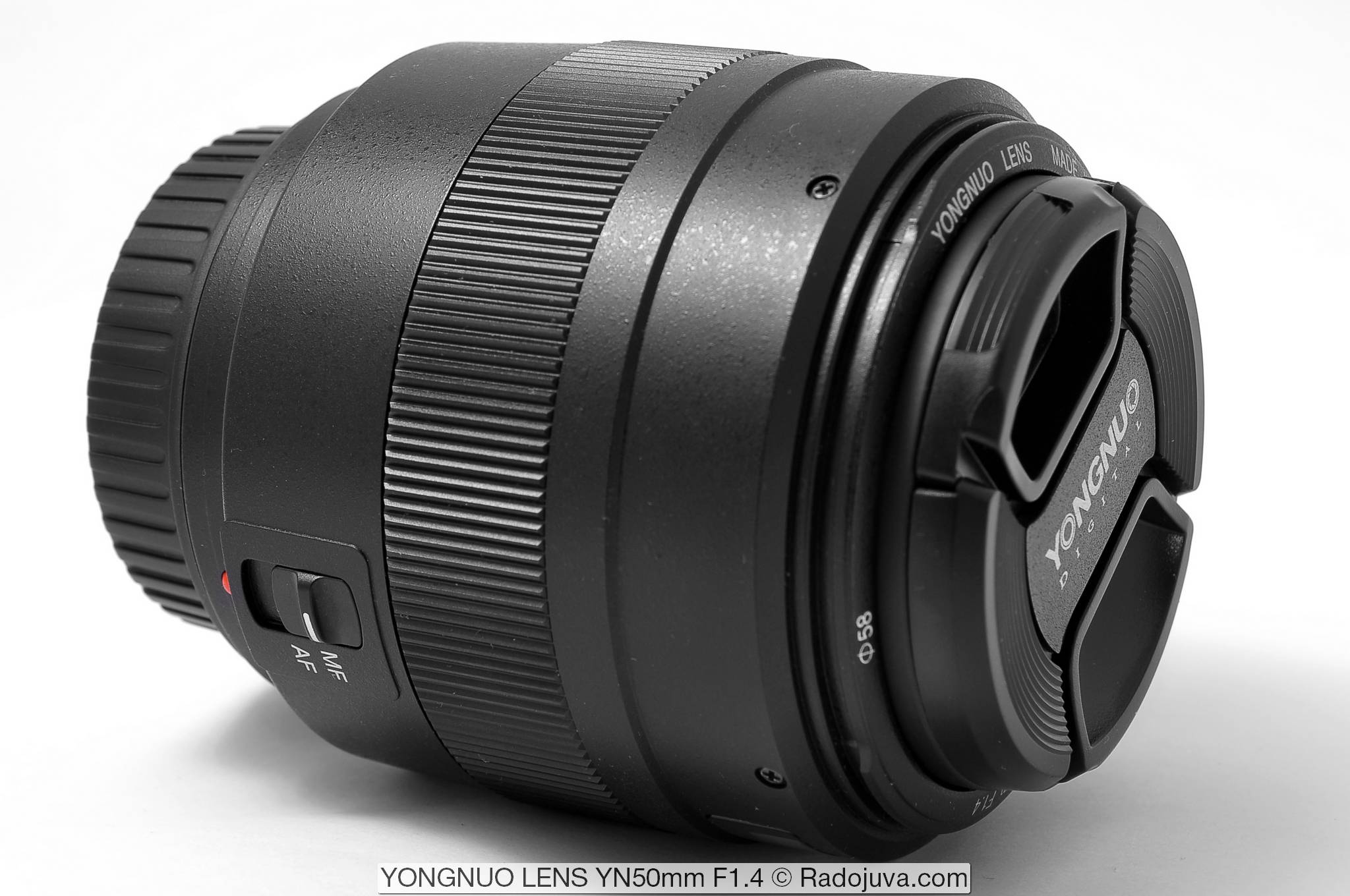
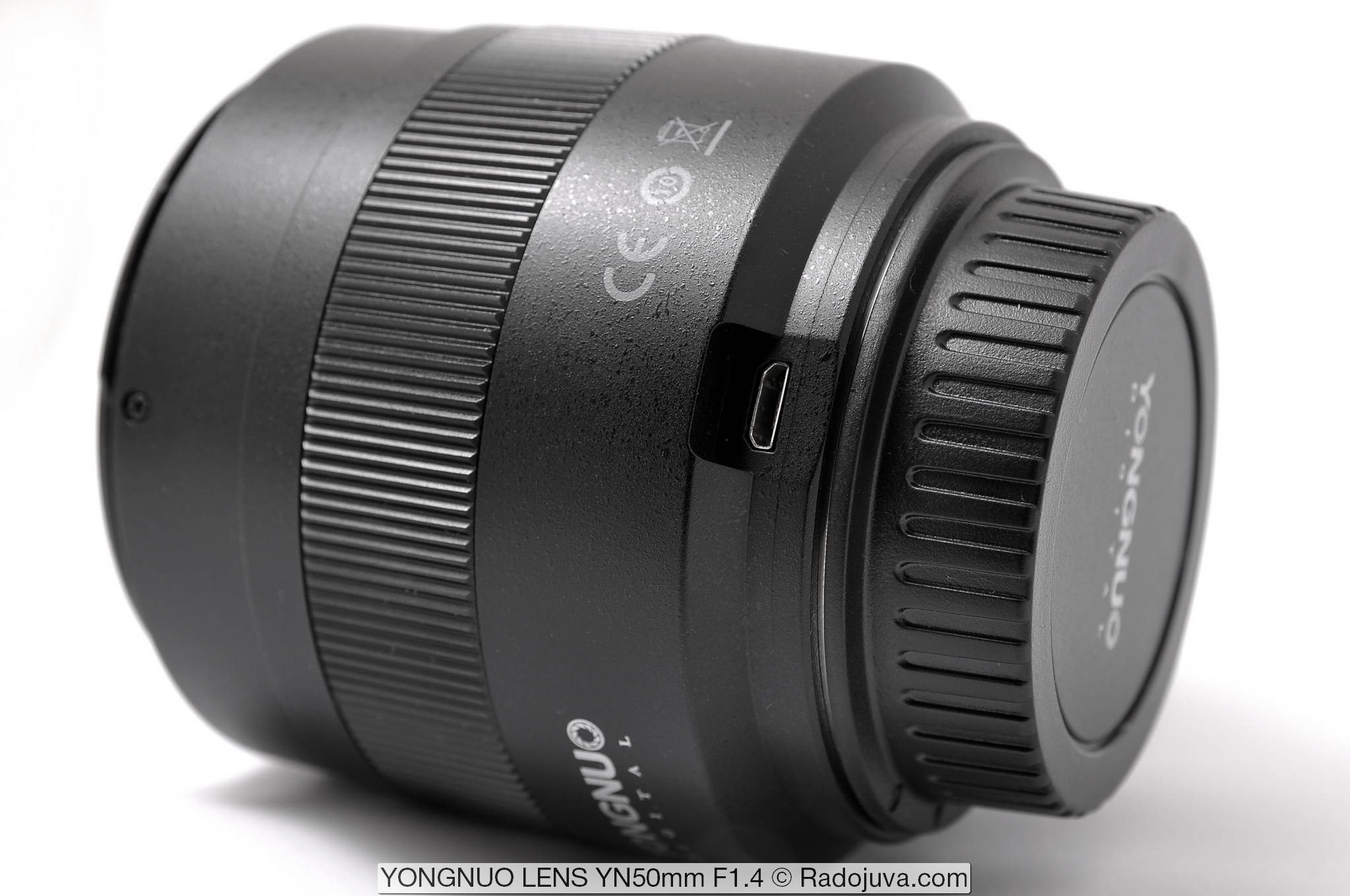
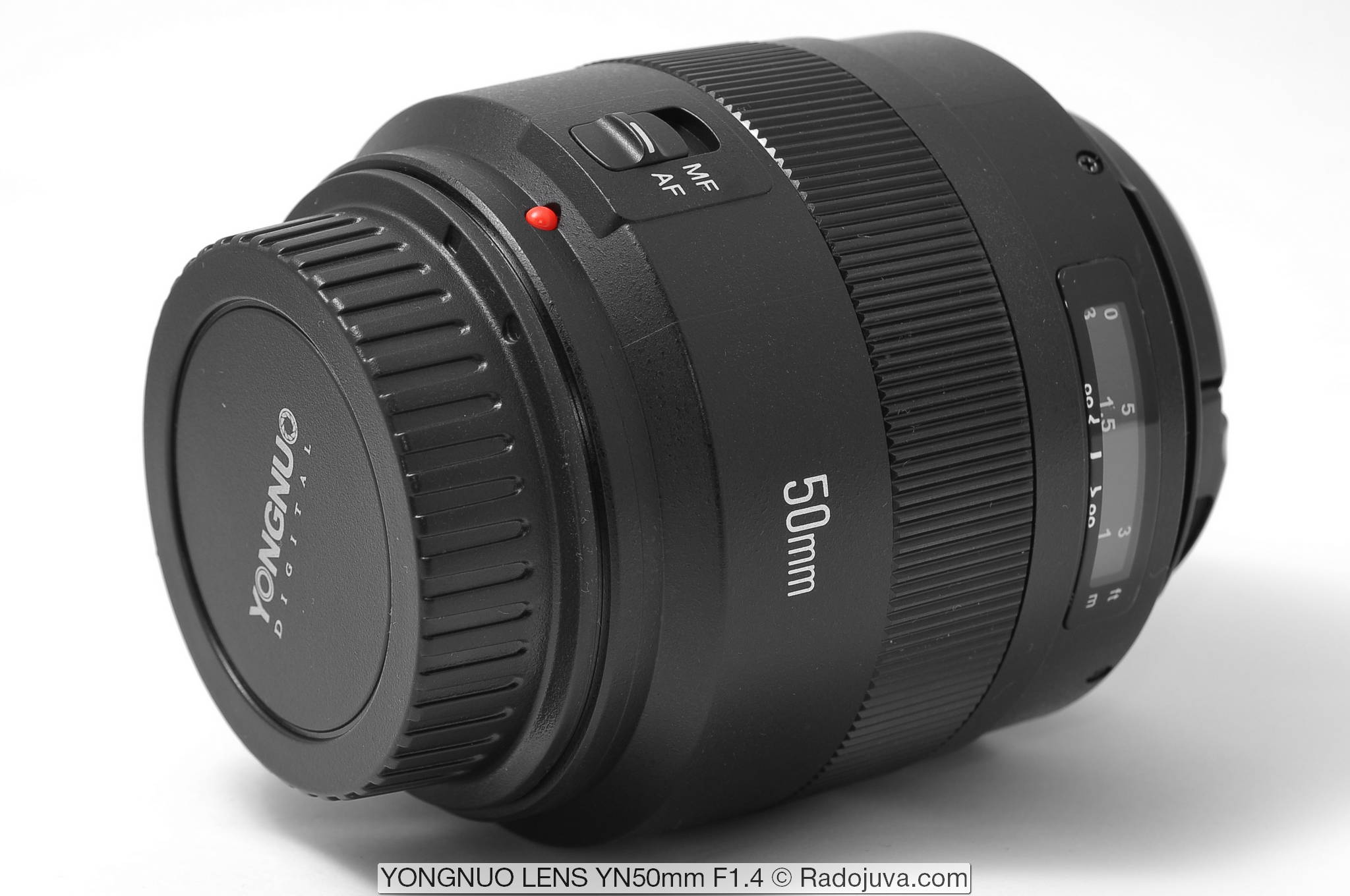
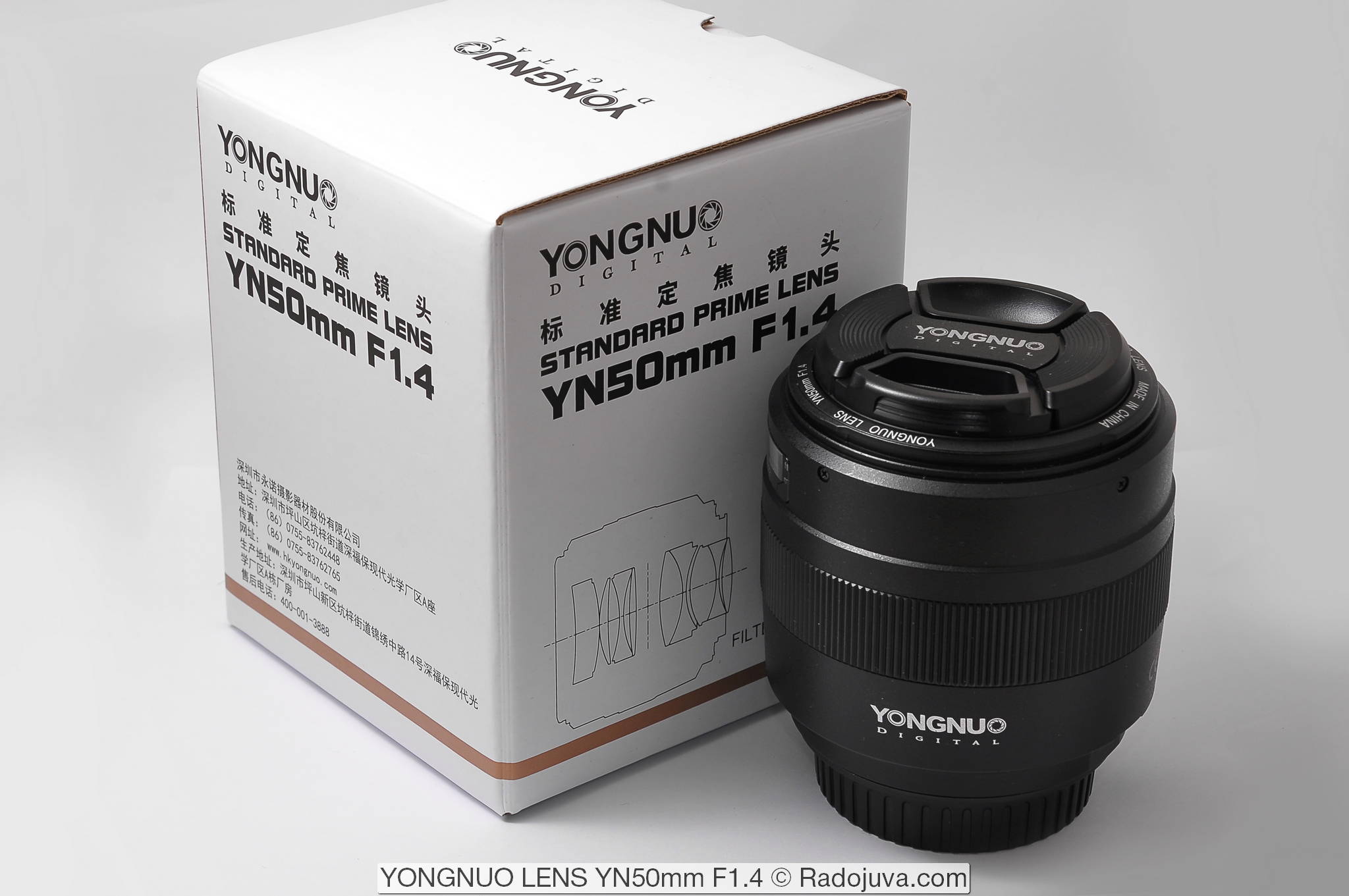
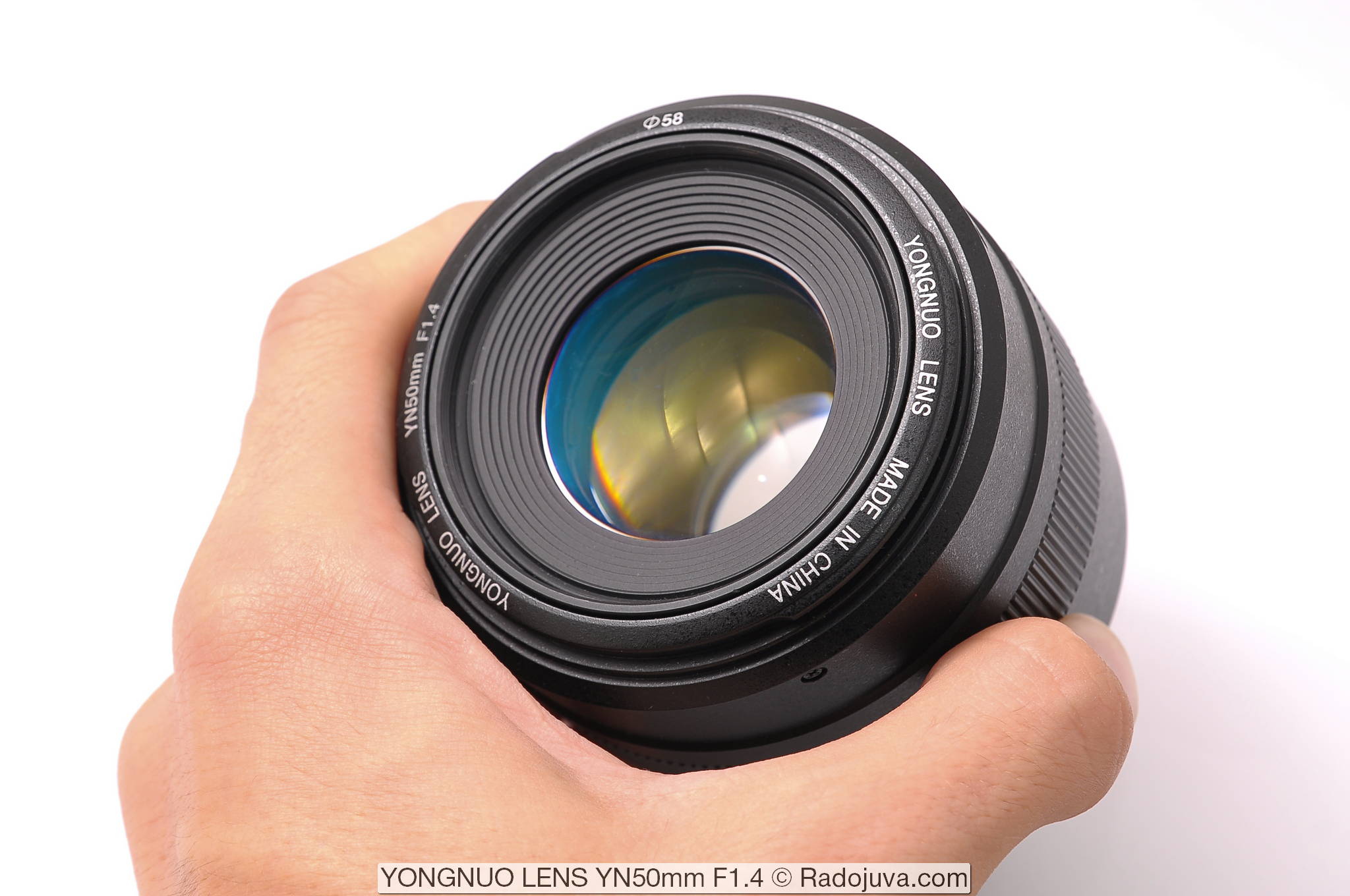
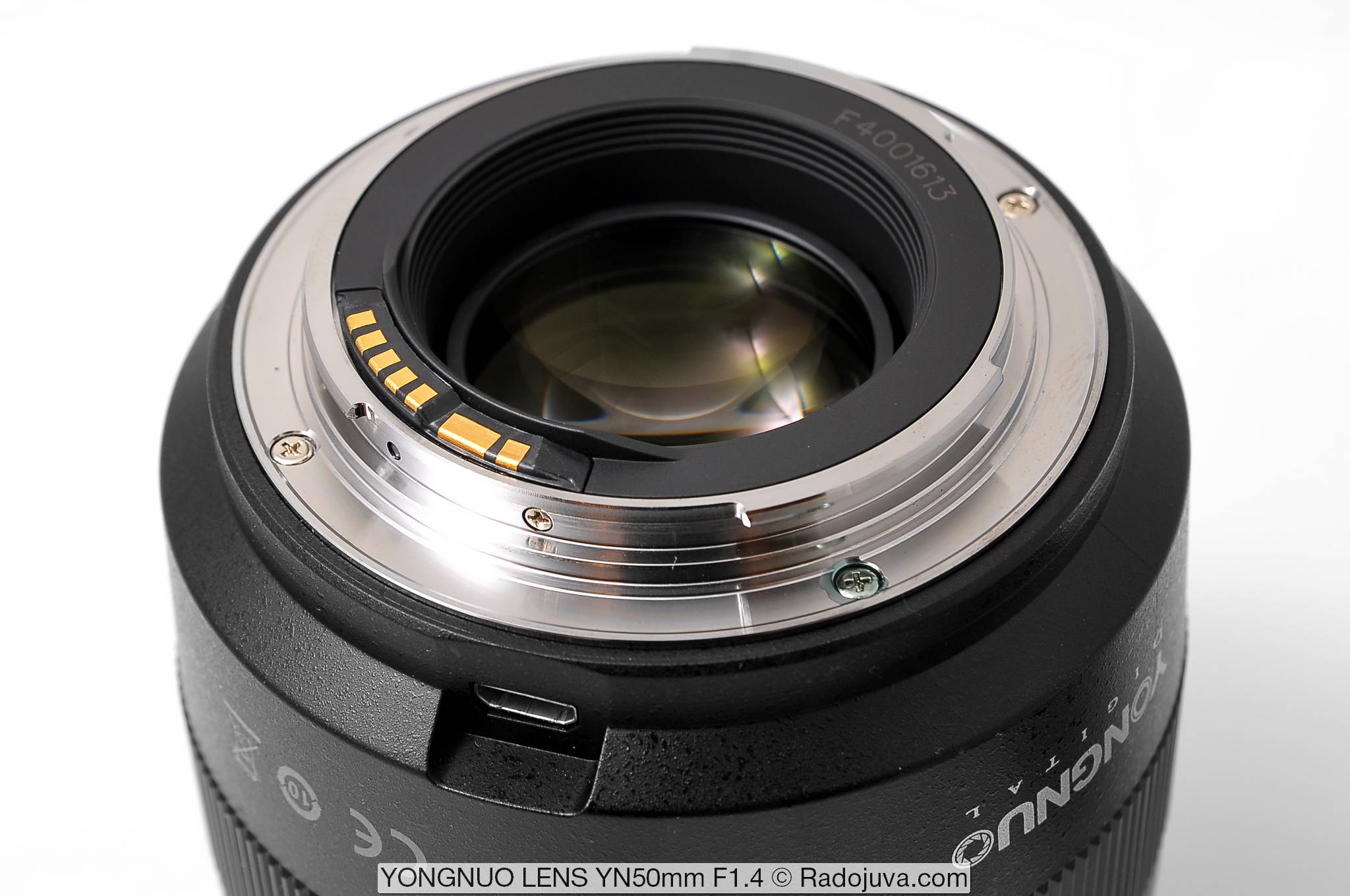

Hello! I bought a lens, 2 weeks ago, it worked, everything was fine, I turn on the camera yesterday, take a picture, and I get an error eror 1 there is no lens connection with the camera, the camera is Canon 6 d, the camera is a new lens too, tell me what it could be
Remove-put lens
I took it off, and the battery was removed, the seller, sent the firmware, and the program, the firmware, even the lens does not see,
I initially came off. Error EPP1. But mine was flashing firmware without any problems. I had to open it. There was obviously some kind of repair in mine, because there were traces of terrible post-assembly soldering (moreover, one screw, as expected, was clearly varnished with factory varnish, that is, it was probably repaired at the factory) In general, the soldering on the cable that goes from the board to the bayonet connector was poorly washed and 4 (!!!) out of 8 contacts did not end up ringing. I had to lightly wipe and solder the left loop on the top. Working.
Most likely still got married
The price is of course captivating, but personally, with a modest budget, I came to the conclusion that I’d better pay more, but I’ll take the original lens, rather than use third-party products at my own risk.
Hello Arkady! Thank you for the reviews of photographic equipment. Can you check the autofocus performance of the YN 50mm f1.4 lens on the Canon 450d?
Currently 450D is not at hand
I bought myself one after your article. I have not really tested it yet, but there’s clearly no child sore f1.8. Of the shortcomings - very loud.
There is a Canon 1200d carcass. There is already a Canon 1.8 STM, but let's say it does not suit in terms of sharpness up to 2.8, and at 2,8 the background does not really blur. Does it make sense to try the YN 50mm f1.4 as a replacement?
There is a sense, but if the 1.8 STM did not suit the sharpness, then the YN 50mm f1.4 did not go far from it. Here, the problem is no longer with lenses, but with 18MP at crop. At an open aperture, it is unlikely that any budget lens will “beat” the 18MP with 1.6 crop.
Or Sigma 1,4 Art or Canon 350d? I certainly exaggerate, but I think in the right direction?
Not only there is Tamron 45 / 1.8, Sigma 40 / 1.4, Tamron 60/2 macro (under crop). And on many full-frame cameras, pixel density is also low.
Please give a link to read about it!
About the difference in sharpness on crop and full
For example here.
People, share, with whom, with focusing accuracy? I have 1Ds mark 3, and on 1.4 a pretty noticeable focus error
Sensible front focus on the 77D.
Me too. But he introduced an amendment. However, the focus can go to either side, and quite often)
From a meter and a half distance the soap is farther on for sure, using the Canon View 80D Live View
Thanks for the interesting review!
At closed apertures, starting from about f / 2.8, it will be extremely difficult to distinguish between shots from the Yongnuo 50 / 1.4 and Canon 50 / 1.4 USM. You said it ... Now I will say: With an open aperture, it will be very, very easy to distinguish between YN and Canon - soap soap on Canon, razor-sharpness for YN. Like this. For since July I have YN50F1.4 and I shoot only on the open. Only!!! And what a honey-creamy bokeh! I am even amazed myself - how can such an optical quality be so cheap? Even putting the antediluvian fifty kopecks from Kenon nearby is blasphemy.
Please do not move off topic. You wrote about the open aperture in the review of the version for Nikon, now F / 2.8 has appeared here. Also, you made a mistake in other things that I pointed out in a previous comment in the version overview under Nikon.
Take a look at the corners at F / 1.4 on a full frame, after which I advise you to be more critical about praising. Although, of course, I'm glad that you like the lens and you always shoot “only in the open”, as well as “honey-creamy bokeh”. I hope this approach will be shared by other users (or not).
Please tell me, what is a good alternative to old-school manual inexpensive, so that 1.4 or less?) And 35 mm is preferable to crop
35mm F / 1.4 for SLR cameras is not cheap, and 35mm F / 1.2 and less and more so.
From autofocus, there is only one budget option - Sigma 30mm F / 1.4 EX HSM.
Thank you
But does it make sense to take for example MINOLTA Rokkor 50 / 1,4 and an adapter with a lens? It's all for about 3500. Will the adapter affect quality and aperture?
I do not see the point
Yesterday I received one for my Canon 5D Mark II. In a couple of days I will test and unsubscribe.
Arkady, how is this lens with light transmission? With the same aperture, shutter speed and ISO settings, how does it behave compared to the Yongnuo 50 1.8N, Nikkor 50 1.8G and Nikkor 50 1.8D?
Canon 1200d For Sasha And in your device, the sensitivity af is low and high-aperture optics may not work correctly.
What about Zenithar 50 1.2. they are at the same price. Here to compare with it, otherwise I am faced with a choice. Understandably manual zenithar, but the yongnuo is not so hot autofocus.
The site has a review of the zenitar - you can compare)
Hello, Arkady. Really like your reviews. I am pleased to read them. Tell me which lens is better in your opinion yongnou 50 f1.8 or yongnou 50 f1.4. And there is also a set of nikon d5500 + sigma 17-50 f2.8 is it worth it to buy yongnou 50 as a portrait, is the picture much more advantageous compared to the sigma at the long end, thank you in advance for the answer
Yongnuo 50 / 1.4 is better than Yongnuo 50 / 1.8. For Sigma 17-50 / 2.8 OS you can buy the native Nikon 50 / 1.8G AF-S, the quality of pictures will be higher than that of Sigma
Thank you, I understand correctly, the native nikon 50mm f1.8g is preferable to yongnou 50mm f1.4?
Yes, they understood correctly. At least this is my personal recommendation
> Most likely the optical design of the Yongnuo 50 / 1.4 belongs to some old and unreleased Nikon / Canon lens that did not reach mass production.
This is unlikely - at least Canon it definitely cannot be. As you point out, there are as many as 4 “special optical elements with a super high refractive index (shown in blue)” in the optical scheme - these elements are very expensive from Canon and they do not use them in bulk - I think Nikon has a similar situation. Most likely, these elements are closer to lanthanum glasses than to modern ultradispersive ones.
New schemes for Chinese lenses are calculated at the Shanghai Institute of Optics, here in China several monthly magazines on optics and optical production are published, do not forget that the Chinese have recently built and launched the world's largest telescope, and all this is about their own efforts. Since ancient times, mathematics has been very developed in China, and now it is very developed here, and physics is developing by leaps and bounds, plus cheap rent of supercomputers, it is not difficult to calculate lenses in the modern world, especially - fifty dollars. Look better at the use of special low-dispersion lenses in it, a few years ago I wrote here that soon Chinese companies will start using special lenses in their lenses, because I knew for sure that several Chinese companies at once mastered the production of very high-quality optical glass, all this is due to the fact that China plans to become the number one space power in the near future, and all these lenses are just flowers, by-products for the mass market. Do not forget that first-class invited scientists and engineers also work at that Institute of Optics (and that in the same USA only Americans work in scientific research institutes? Of course not, so China invites constantly leading scientists in various industries). No need to look for a cat where it is not, get used to the fact that China is already an advanced country in many industries, or will become one very soon, so the United States started a trade war with him and now Trump has begun to persuade China not to make the planned technical breakthrough by 2025 , for which everything is very ready here, the largest factories are being re-equipped, in fact, only Germany exports to China the latest equipment worth more than 200 billion dollars a year, according to my personal observations, people living outside China do not even imagine what is real here is happening and what level of technical development China will soon reach. It was recently announced that China will build a high-speed rail line from Beijing to Sydney, across the islands and under water, a second line to London and a third line to New York via Alaska. And what is the design of a fifty-kopeck piece compared to that? Moreover, I said and now I will repeat that I am almost sure that soon we will see our own ultrasonic motors in Chinese lenses, moreover ring lenses, and sooner or later maybe some Chinese company will buy one of the Japanese brands and begin to reduce the price of the entire market ...
Now about lanthanum glasses. As far as I know (but my data is inaccurate!) - China does not mass-produce lanthanum glass, in any case, all my friends from various institutes who are associated with the production of glass as such answered that they do not produce, until they do. Moreover, in China, ordinary borosilicate glass is not yet produced on a mass scale, but is purchased in various countries including Russia. But there is information that fluorite glass is being produced, but not yet for the mass market, apparently they have not yet been able to reduce the cost of production. And the production of ordinary optical glass, which for another 15 years cost about $ 1000 per 1 kg, has already been mastered and now the Chinese even sell such glass in many countries, including Japan itself, and the cost has already been brought to $ 320 per 1 kg, that is, they have already been able to reduce the price by three times. That is why cheap lenses appeared, first within China itself, and then in other countries. Look at the new AF-P lenses from Nikon and STM from Kenon, why are they suddenly so cheap that the companies are kinder? Of course not, they just started buying cheap optical glass from China, but no one talks about it. By the way, the quality of these new and cheap lenses is higher than that of the old expensive ones, all reviews on the internet confirm this. With the support of the state, planning the economy and the need for goods, there is nothing impossible in the world, pre-revolutionary Russia was also a very backward country, but in the period from 1917 to 1953 it made an unheard-of breakthrough in the entire world history, also now with China ...
Thanks for the political information. The Chinese are well done.
Good day! Did new firmware come out on it, did it flash? Maybe there is something to add? Who tried it on 6d mark2?
Arkady, didn’t it seem to you that the aperture of marketing is slightly overpriced? On the Canon 50mm f1.4, the shutter speed is shorter.
There is a geometric aperture, which is determined by the ratio (I do not remember exactly which one) of the focal length and, roughly, the diameter of the front lens. And there is an effective aperture ratio, which also takes into account the light transmission of the glass (loss of opacity and reflections). It is indicated on cine lenses - like T3,1, for example, for a lens with a geometric aperture of 2.8, so that there are no nuances when shooting with different cameras, and the exposure was the same everywhere. So the yongi may well have an effective aperture of T2, and the canon - T1.7 or something like that.
Focal / diameter.
Good afternoon. Arkady thanks for the excellent review. If you multiply - I will be grateful. Interested in whether the mirror of the canon eos 3 (film) camera will cling? Or does it make sense to buy the original fifty dollars ...
He’s actually using an ef mount, so he shouldn’t
It will not and should not cling.
I bought this lens for Canon in November 2018. It cost ali 10600 rubles. Everything was wonderful, the lens pleased with the picture for the money, but yesterday when I turned on the camera gave an error Er 01 (lack of electrical connection between the camera and the lens). With other glasses everything works fine. I tried to change the firmware, but the computer also does not see the USB port. Apparently, a loop or processor of the lens was covered. Very upset by such a fragility of the glass. Previously purchased 35mm and 100mm from this manufacturer are working properly, but it’s fifty dollars when shooting. I don’t even know where to go for repair or at least diagnostics, because I took from the officials on Ali. Therefore, I advise you to buy this lens where you can use the warranty, and it’s 12 months, as it were. He lived with me for 4,5 months. Filmed on premises, did not drop, did not drown, stored in a dry place.
As far as I know, this fifty dollars burns out the track of the microprocessor or microcontroller. Any workshop should be repaired. There have already been similar cases. The repair price for owners varies between $ 20. When there will be more data sampling, I will add this information to the overview
Thanks for the information. I'll give it to the workshop for diagnostics. I hope the price does not exceed the cost of the lens.
Good afternoon Arkady! I want to note the first! I started reading the blog back in 2012. Thanks for the helpful articles and reviews. I have a question about the firmware of this lens, where there are reviews about the received updates of this optics. I have the firmware version from the box. I can not find on the Internet ..
Good day. Most likely this is not discussed anywhere. Version 1.06 has been released, I do not think that it will worsen anything. According to official data:
V1.06 2018-12-27
1.Repair the problem that 7D II camera can't focus automatically
2.Other improvements
V1.05 2018-12-11
1.Repair the problem that EOS M6 camera can't focus automatically
2.Other improvements
V1.04 2018-10-13
1.Optimizing the stability of video recording
V1.03 2018-6-27
1. Optimize AF Performance
2. Fix the inaccurate exposure, when the lens is used on the 80D / 6D II camera
3.Other improvements
V1.01 2018-6-22
1. Improve the compatibility of SLR camera;
2. Improve the compatibility of eos-m camera;
3. Fix some camera focus less problem;
4. Other improvements.
Thank you Updated. Information for the owners of this optics.
After the update, I noticed improvements in the work of aftofocus, the lens became more frisky and tenacious. The back focus problem on f1.4 has gone.
I’ll add on my own. This lens covers my creative filming and workdays.
I twisted the focus setting value +20 on the camera.
Prior to that, there was a noticeable back focus. But expecting 1,4 excellent AF performance is not worth it, even on other instances of optics. The statement to the firms will also be true. An extreme aperture podium of 1.8 was shot, more than pleased with the result. Depth of field is very different from the same Canon 50mm 1.8, it is deeper and covers the entire frame. This is a success for this optics. Photographers believe that their work or creative filming will be better from expensive analogues, I will disappoint. Decides the ability to work with technology.
Hello!
Please advise! Take me a Canon 50mm F1.8 or YN 50 mm 1.4 for a Canon 70D carcass? I need it more for a portrait. Or does it make sense to add another half the cost of this lens, and take a used Canon 50 mm 1.4?
There is simply no way to rent this YN or from friends and compare ...
For previously grateful for the answer.
Native optics are better
Sergey, I can advise both of them. But new glass is many times better than used.
If the examples from the catwalk are interesting, then go to my channel in the telegram @ creativeillillusion.
Good lens came from Chinese friends
Will the D650 not be buggy? How in group shooting is not very? or for crop 35 it’s better to search through the pictures did not quite understand about the sharpness
thanks for the review, waiting for an answer
For groups on the crop, 35 will be too narrow.
maybe I'm fussy 4 photos went out portraits in a red cape